
MWST continues its tour across three continents
The Magallanes World Study Tour (MWST) which kick-started on 20 May 2021 at its first station with University of Limerick, Ireland, continues with the tour stopping by at its remaining stations with Jiangsu Normal University, China; Meru University of Science and Technology, Kenya; King Mongkut’s University of Technology, Thailand; Guizhou Normal University, China; University of West Attica, Greece; Hungkuang University, Taiwan, and its final stop at UTAR. The virtual international study tour aimed to offer the participants from various economies a platform to connect with each other and to experience the diversified cultures, traditions and languages via Zoom.
Station 2: Jiangsu Normal University, China
Station two’s “A story from Jiangsu Normal University (JSNU)” attracted more than 240 participants. The virtual tour was led by JSNU students. They began with an introduction on “Four New Icons of Creativity in China” by JSNU School of History, Culture and Tourism student Sun YaWen.
“When you visit China, the four things that you will commonly see are high-speed railway, QR code scanning payment, shared bicycles and online shopping. The high-speed railway and QR code payment system are two things that are used by Chinese people every day. The high-speed railway in China is safe and consumes low energy because it applies the automatic operation system. The high-speed railway will be set up all over China in the near future so it is even possible to travel globally. China people uses the QR code payment everywhere except for some necessary occasions. The QR code payment offers a more simplified payment process which requires devices with corresponding software, compared with traditional POS card swiping,” said Sun.
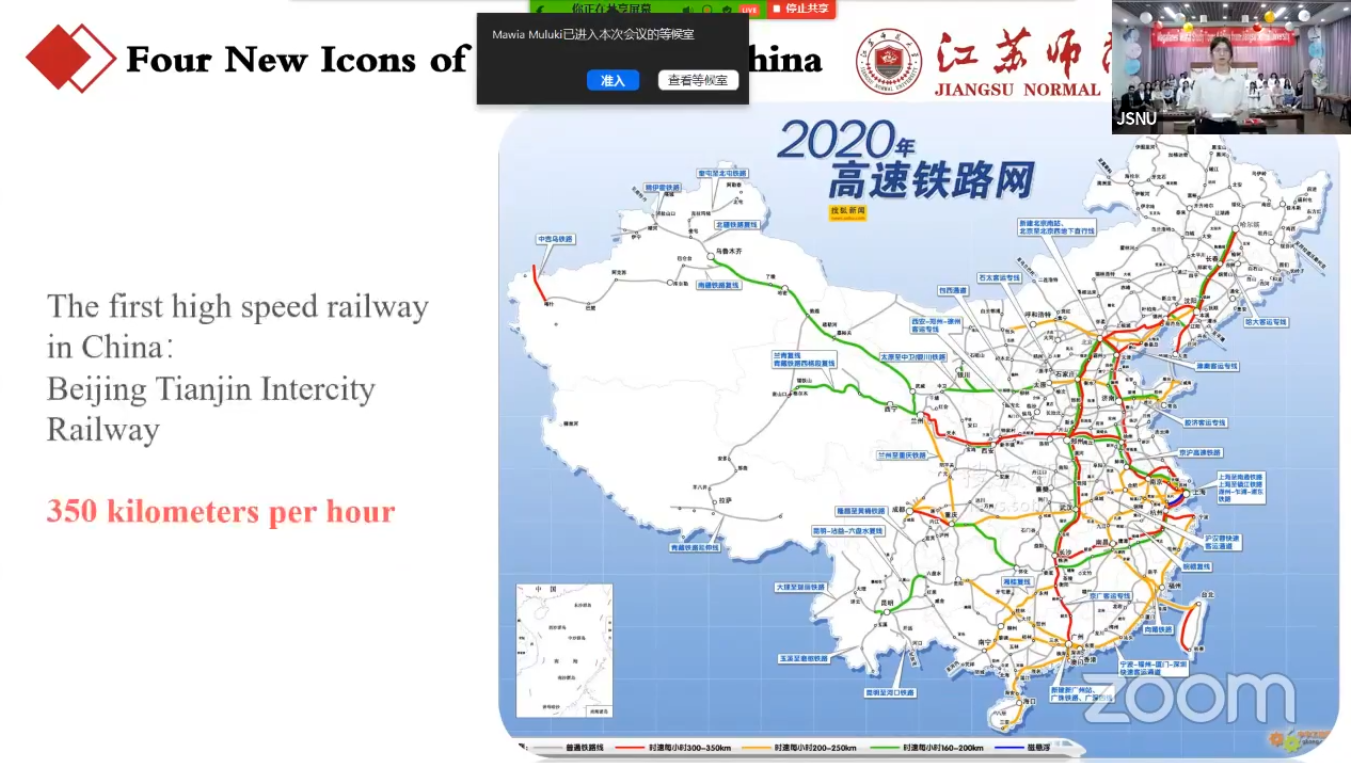
Sun introducing the first high-speed railway in China, namely the Beijing Tianjin Intercity Railway
She added, “‘Shared bicycles’ is very common in China. You can unlock any share-bike by scanning, using mobile app on your phone. You just need to return the share-bike to the specified location and the payment will be done automatically via online. Besides that, online shopping in China is becoming the most rapidly developed model of shopping in all consumption situations. It has changed the traditional operation and management mode in the retail sector. With the large popularity of the internet, the online shopping now has entered the agriproduct shopping to build a new type of socialist villages.”
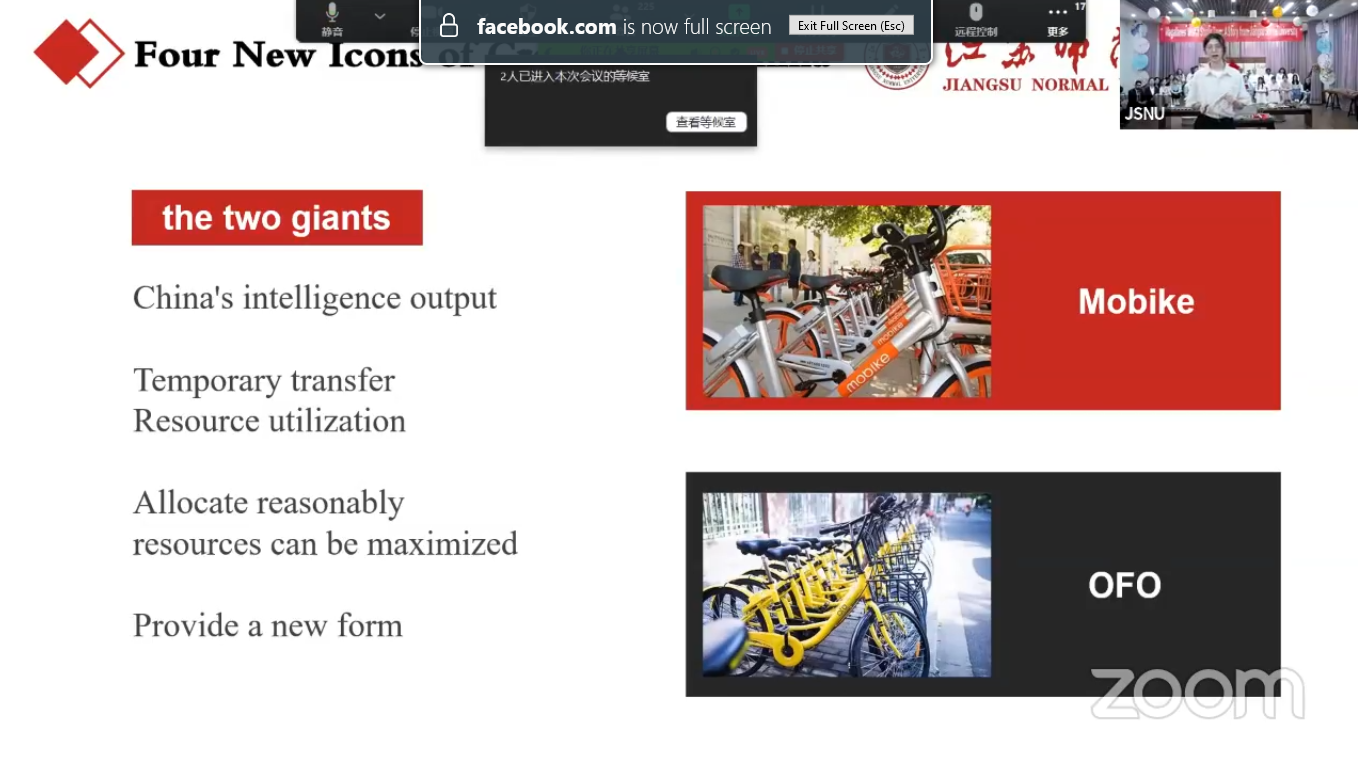
Sun briefly introducing the two giants of share-bike in China
Other students from JSNU School of History, Culture and Tourism also presented on “Xuzhou as the Cradle of the Han Culture”, “Xuzhou as a Historic and Cultural City”, “Xuzhou Cuisine” and “The Kaleidoscope of Xuzhou Today”.
Xuzhou was deemed as the cradle of the Han Culture because Liu Bang, the first emperor of the Han Dynasty was born in Xuzhou. Therefore, Xuzhou be described as the birthplace of the Han culture. “Han Fu” is traditional clothes of the Han culture. It can be separated into two types; the casual wear or the formal wear. It is believed that the traditional dress of Korean’s “Hanbok (韩服)” and the traditional dress of Japanese’s “Kimono(和服)” were developed from Han Fu and they changed over time. JSNU as a local university of Xuzhou has replaced the western graduation grown with “Han Fu”.
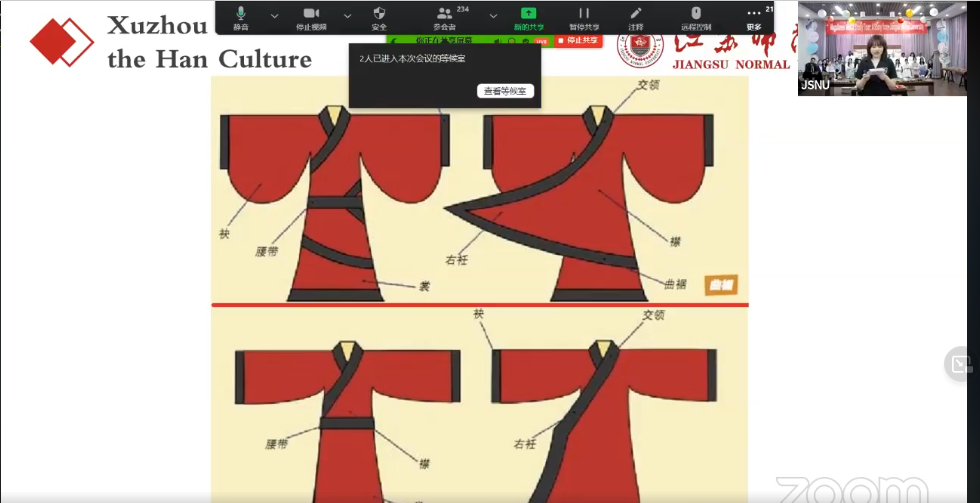
“Han Fu” is one of the symbols that represents the Han Culture
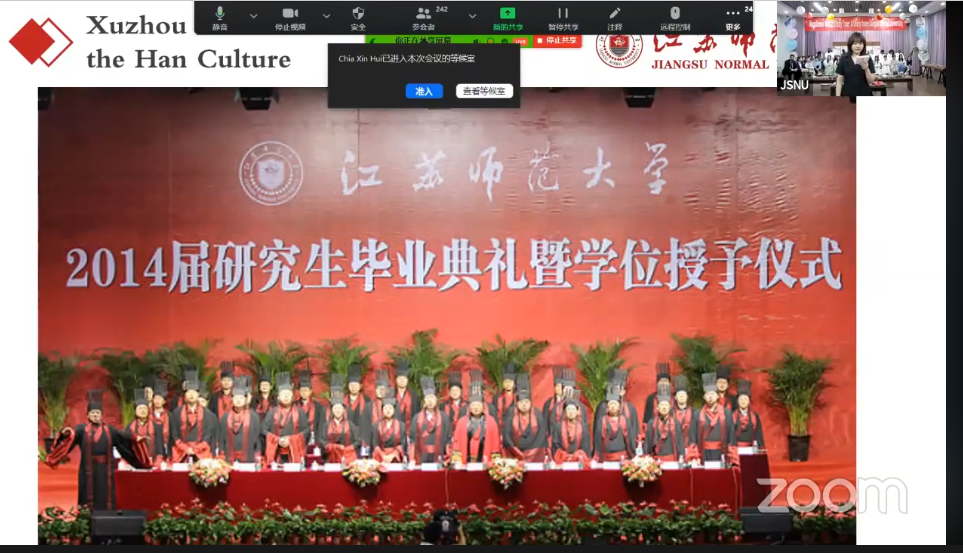
“Han Fu” as the graduation grown for JSNU students
The stone reliefs, Terracotta Warriors and Horses as well as the Kings’ Mausoleums are the cultural heritages of Han Dynasty in Xuzhou. The original Stone Reliefs during the Han Dynasty are now collected in the Exhibition Hall for Cultural Relics in the Han Dynasty on the second floor of Xuzhou Museum.
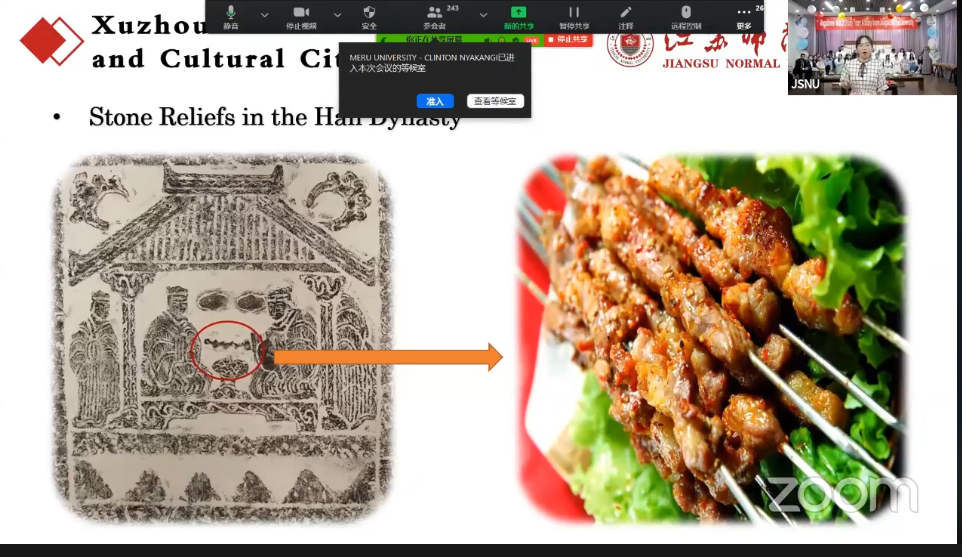
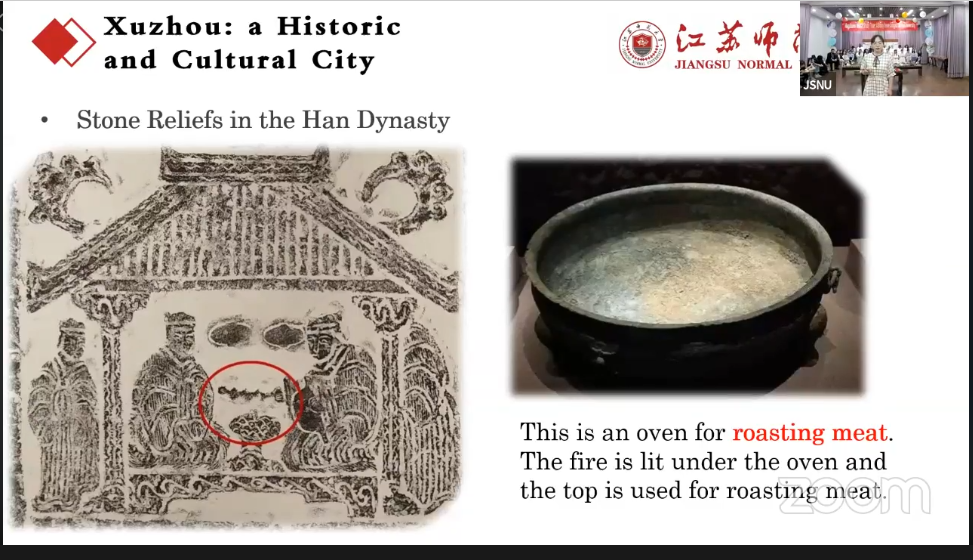
The Stone Reliefs in the Han Dynasty are now kept in the Xuzhou Museum
The Terracotta Warriors and Horses were created because of a philosophy during the Han Dynasty which believed that “death” is the switched form of living in another world. Thus, some lords and senior generals with heavy armies hoped to resume their commanding over thousands of troops after their death.
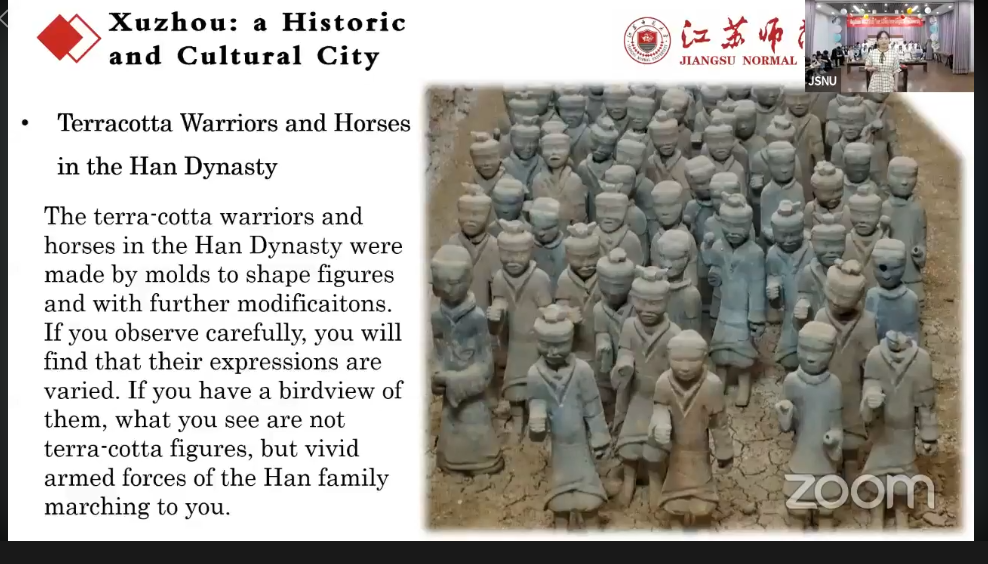
The Terracotta Warriors and Horses in the Han Dynasty
Guishan tomb of the Han Dynasty is one of the famous Kings’ Mausoleums with its huge layout and exquisite architecture. It was the tomb for King Liu Zhu and his wife. King Liu Zhu was the sixth ruler of the Chu Kingdom in the Han Dynasty.
Due to its location, Xuzhou food combines Northern and Southern cuisines. The famous dishes in Xuzhou including “Shatang”, Fish wrapped in mutton and Dongpo pork. “Shatang” was first made by Emperor Yao’s Chef – Peng Zu 4,300 years ago. According to a legend, Chef Peng Zu was very good at keeping healthy and was said to have lived for 800 years.
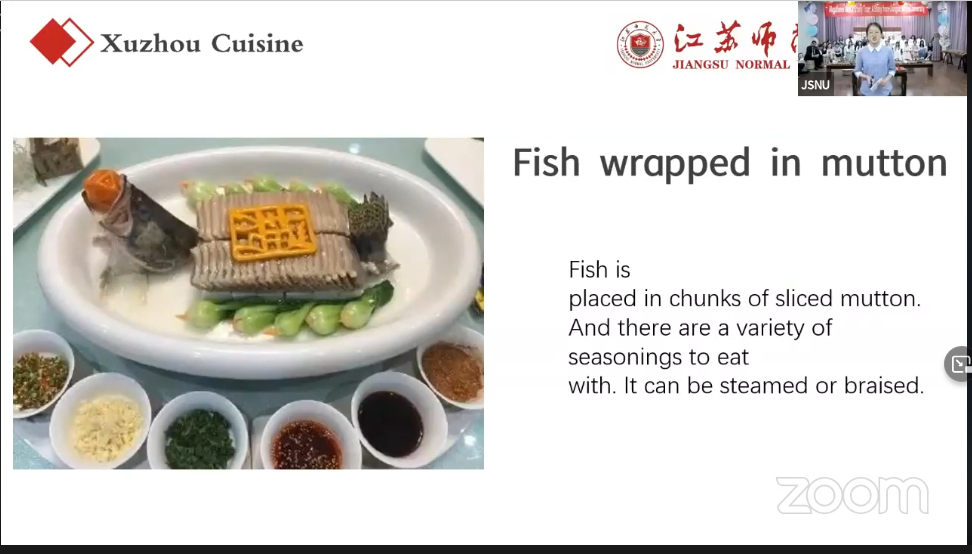
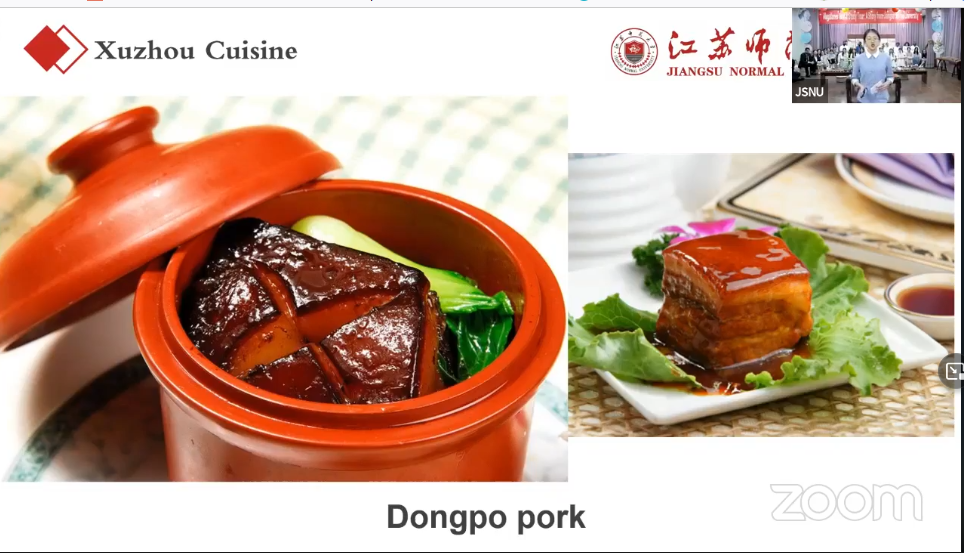
Fish wrapped in mutton (left) and Dongpo pork (right) are famous dishes in Xuzhou
Session two was the introduction of JSNU. JSNU was founded in Wuxi City in 1952 and transferred to northern Jiangsu Province in Xuzhou City in 1958. JSNU has four campuses encompassing 136 hectares. It has been ranked no. 1155 on 2019 U.S News Best Global Universities Ranking and no. 88 in 2018 Nature Index Table. According to the video, JSNU now has 52.9% professors and associate professors who are teaching at the campus. Their percentage of teachers with PhD degrees reaches up to 55.3%.
The webinar was then continued by students from JSNU School of Education Science, Liu LiNan, Zhang MingYue, Zhou YuJia, Zheng ShiJie, Shi YuChen, Yang MengTian and Yuan Yue who shared on Chinese Tea Culture, Chinese folk music, Chinese embroidery and Chinese paper-cutting. Throughout the session, they also presented some arts and cultural performances to the participants.
According to the students, the history of paper-cuttings can be dated back to the early Han and Tang dynasties. Chinese paper-cutting covers the images of people, animals, flowers as well as Chinese characters. Some paper-cutting portray historical stories, myths and legends while others reflect the society or traditional customs.
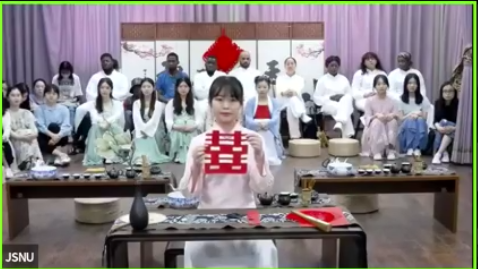
JSNU student showing how to do paper-cutting
Embroidery is another traditional Chinese craft with a history of at least two to three thousand years in China. It is a technique which consists of pulling coloured thread through a background material with needle to stitch patterns that have been previously designed. Chinese embroidery covers a wide range of themes. Take the theme of animals, for example, Su embroidery is good at cars, Yue embroidery is good at phoenix, Xiang embroidery is excellent in tigers while Shu embroidery is famous for its vivid works of carps.
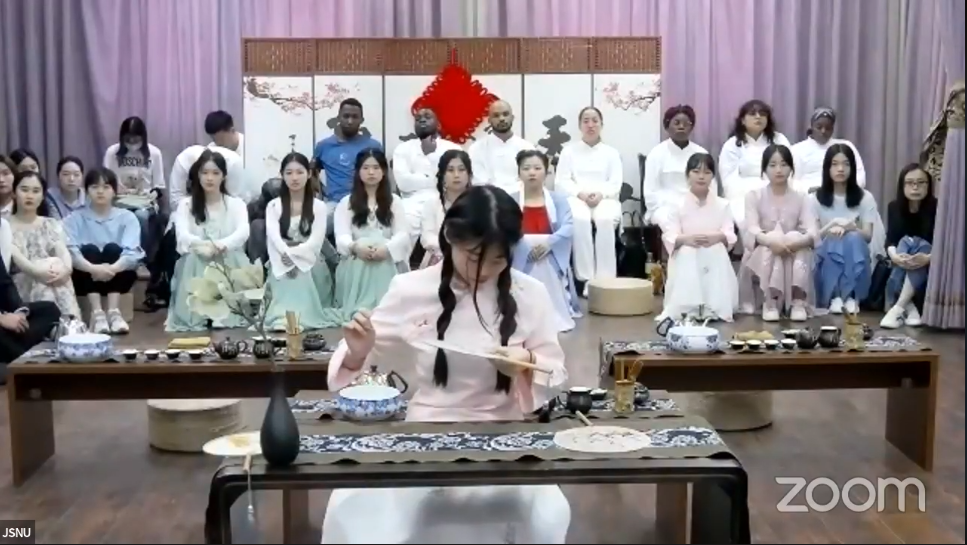
JSNU student showing her skills in Chinese embroidery
The JSNU students also introduced Chinese Tea Culture and Chinese traditional music instruments such as Flute, Sheng, Hulusi, Pipa, Dulcimer, Zheng, drum, gong, Erhu, Banhu, Matouqin and GuZheng.
Towards the end of the webinar, JSNU’s international student Rehman Mati Ur from Pakistan was invited to share his four years of study life at JSNU.
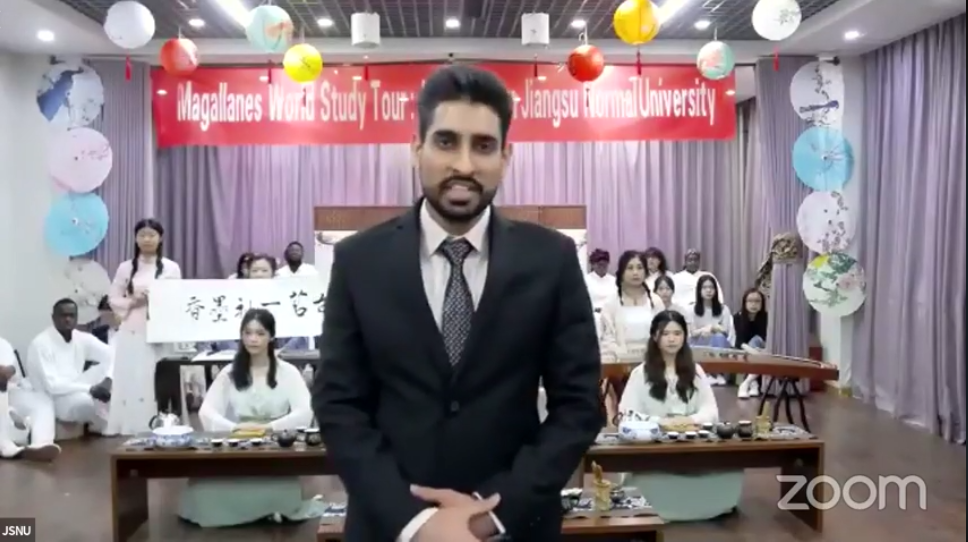
Rehman sharing his study life at JSNU
Rehman said, “I have celebrated many Chinese festivals with teachers and friends. We made the mooncake together during the Mid-Autumn Festival. During my four years of study life, I came to know a lot of friends and joined many events and celebrations with them. One of the main reasons people choose to study in JSNU is because they wish to explore the Chinese culture, new places and also learn new things which are different from their country. Another thing that makes me love my university is the comfortable hostel they provide for the international students.”
The webinar ended with performances by JSNU international students, followed by a group photo session.
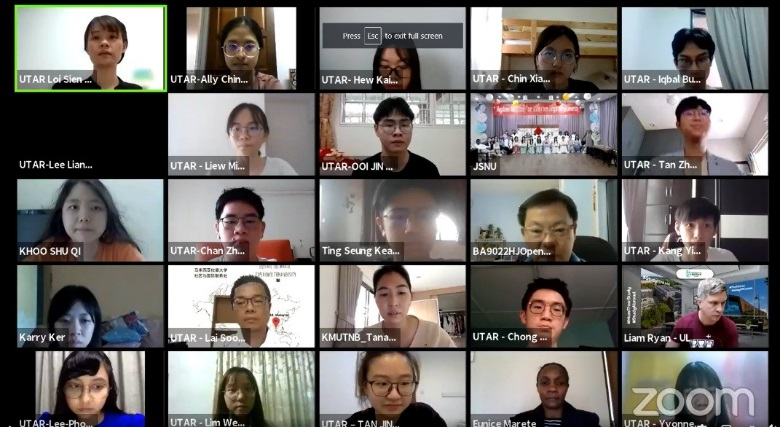
A group photo of the speakers and participants at station two
Station 3: Meru University of Science and Technology, Kenya
The tour at Station 3 - Kenya, guided by Meru University of Science and Technology (MUST), commenced on 14 June 2021. Present to officiate Station 3 was Vice President for Internationalisation and Academic Developmet Ir Prof Dr Yow Ho Kwang and MUST Vice Chancellor Prof Romanus Odhiambo Otieno. The virtual study tour was moderated by Department of Soft Skills Competency (DSSC) lecturer Fong Kah Hoong and MUST academic Dr Naomi Mutea.
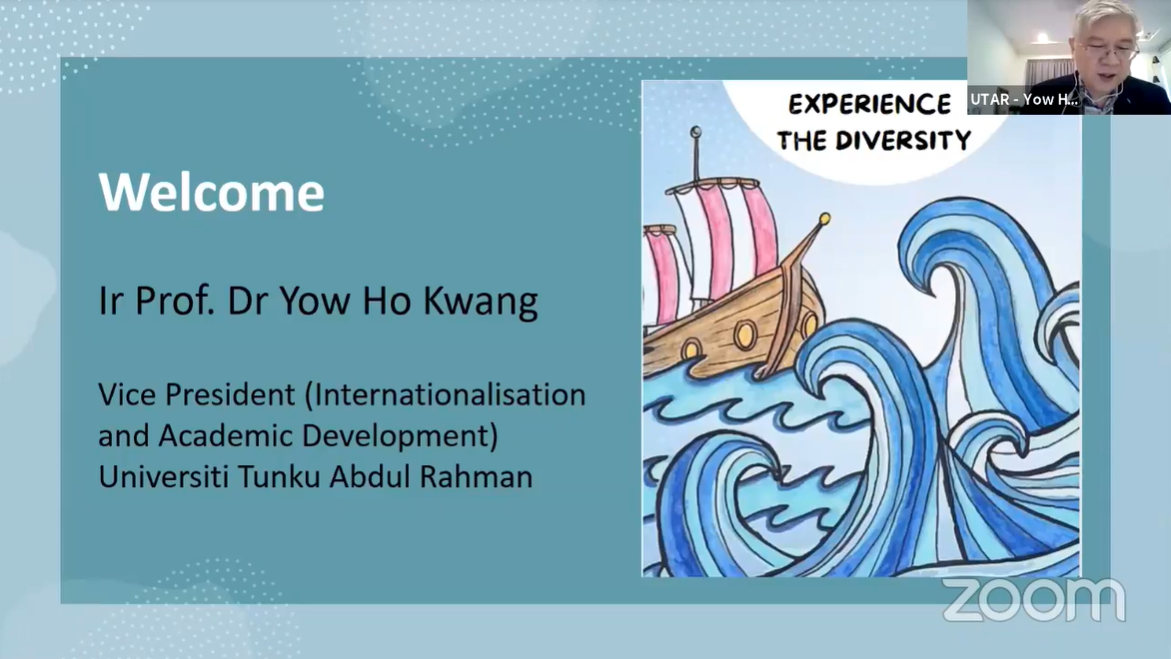
Prof Yow highlighting the cultural knowledge and internationalisation concept to the participants
“This study tour brought all eight economies to engage and learn more about each university’s cultures, traditions, history, languages of their city and locations. Besides, the international exchange not only enhanced the participants’ cultural knowledge, but also promoted the concept of internationalisation at home via virtual platform. Although we are in the Covid-19 pandemic situation, UTAR has always promoted international study tour and exchange, virtually, since March 2020. We are indeed honoured that this programme is continued well until today. I would like to thank MUST for showcasing Kenya’s attractiveness and uniqueness, which is also rich in heritage cultures and traditions. I hope this programme can attract more students to participate in our following stations to gain meaningful experiences,” said Prof Yow.

Prof Romanus delivering his thankful remarks
“I hope UTAR and MUST can work together to have good global networking relationships which can transform and impact the community in the future. Besides, I also look forward to teaming up with UTAR to create good mobility programmes and share ideas or global network to make our university life more exciting,” said Prof Romanus.
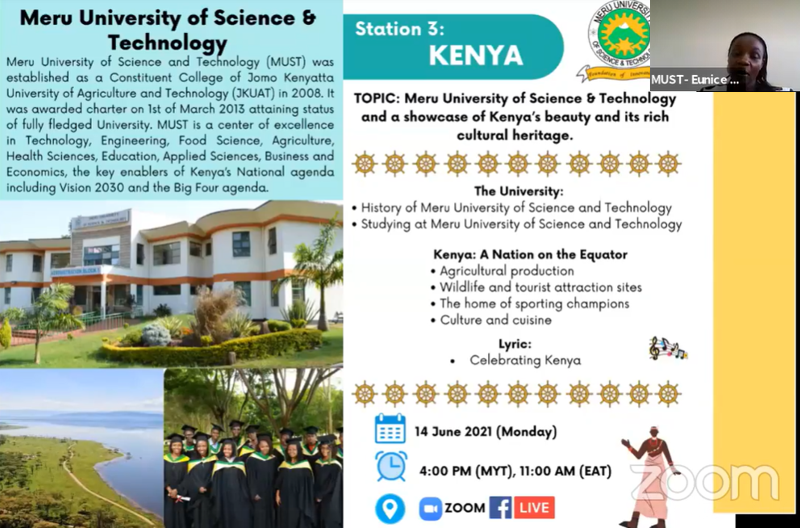
Dr Marete highlighting her presentation topics
The virtual study tour presentation was led by Dr Eunice Marete, who introduced MUST’s history and background, and mentioned that MUST was established as a Constituent College of Jomo Kenyatta University of Agriculture and Technology (JKUAT) in 2008. She conitnued her presentation on “Meru University of Science & Technology and A Showcase of Kenya’s Beauty and Its Rich Cultural Heritage”.
Dr Marete said, “Kenya is situated in East Africa and lies along the Indian Ocean, which is the border by Somalia on the northeast, Ethiopia to the northwest, Uganda on the west, and Tanzania to the south. Kenya has 47 counties as units of devolved government. Meanwhile, the cities of Kenya are Nairobi, Mombasa and Kisumu. Kenya became the Britain’s East African Protectorate in 1895 and a British colony in 1920. The British settlers formed a government and the Africans were prohibited from direct political participation. The African representatives were permitted to sit in legislature starting on 1944. Besides, Kenya gained its independence from the British on 12 December 1963 which is known as Jamhuri Day, where Kenya became the Republic of Kenya with Jomo Kenyatta as the first president. Kenya is Democratic Republic, where the president is the head of state and government.”
She continued by elaborating on the education system in Kenya. She said the formal education in Kenya was introduced by the British Colonial Administration, and the commission was set up to review the Education system and to embrace the national identity and unity. Apart from that, she said Kenya’s tourism is the second largest source of foreign exchange revenue especially in agriculture as Kenya’s climate has the pleasant weather conditions all the year. Apart from that, Dr Marete also showed the wildlife habitats in Kenya, which included the buffalos, elephants, lions, rhinoceros, leopards, giraffes, zebras and flamingoes. Besides, Dr Marete also showed participants the attractive tourism places in Kenya namely, Mountain Kenya, Thompson Falls, the Hell’s Gate Park, Menengai Crater, Fort Jesus, and Mountain Ololokwe Samburu.
Dr Marete also briefed about the Kenyan Culture and Cuisine. She stated that there are 42 ethnic communities and the largest was the Bantus. Every different community has its own distinct languages, dressing, music and native foods. She elucidated that there is a programme under the Ministry of Education that nurtures the artistic talents in music and drama, and their main objective is to promote Kenya’s cultures as one of the goals of education, as well as promoting extra curriculum activities, which serves as a platform for pupils and students to express their cultural activities competitively.
The interactive virtual study tour ended with Q&A group photograph session. The video can be viewed here.
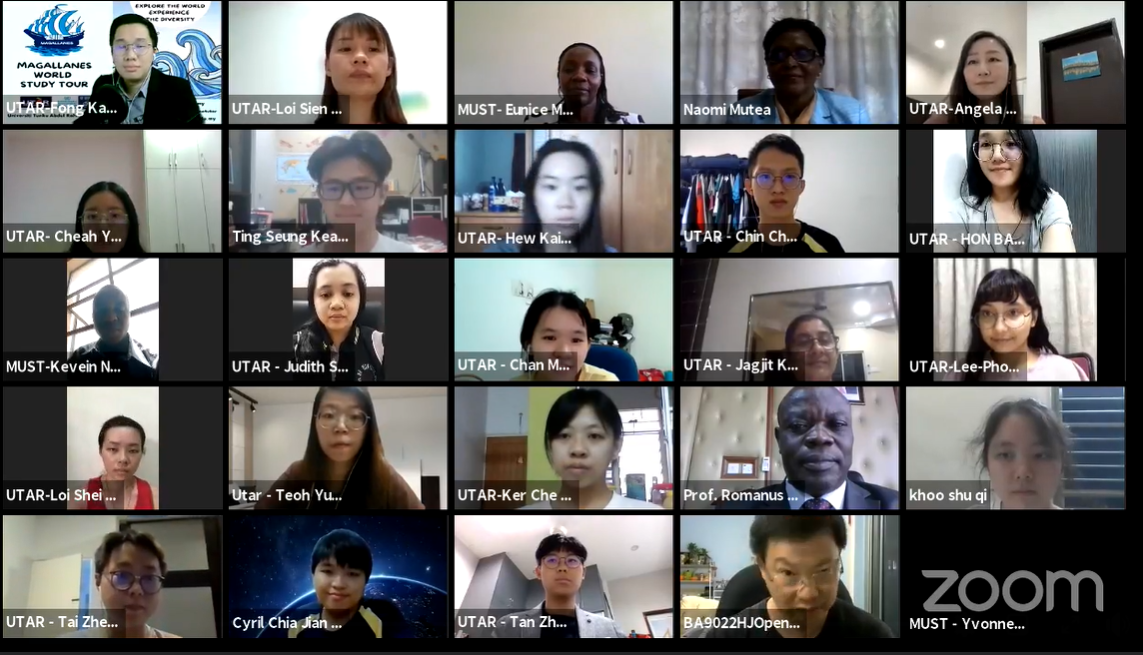
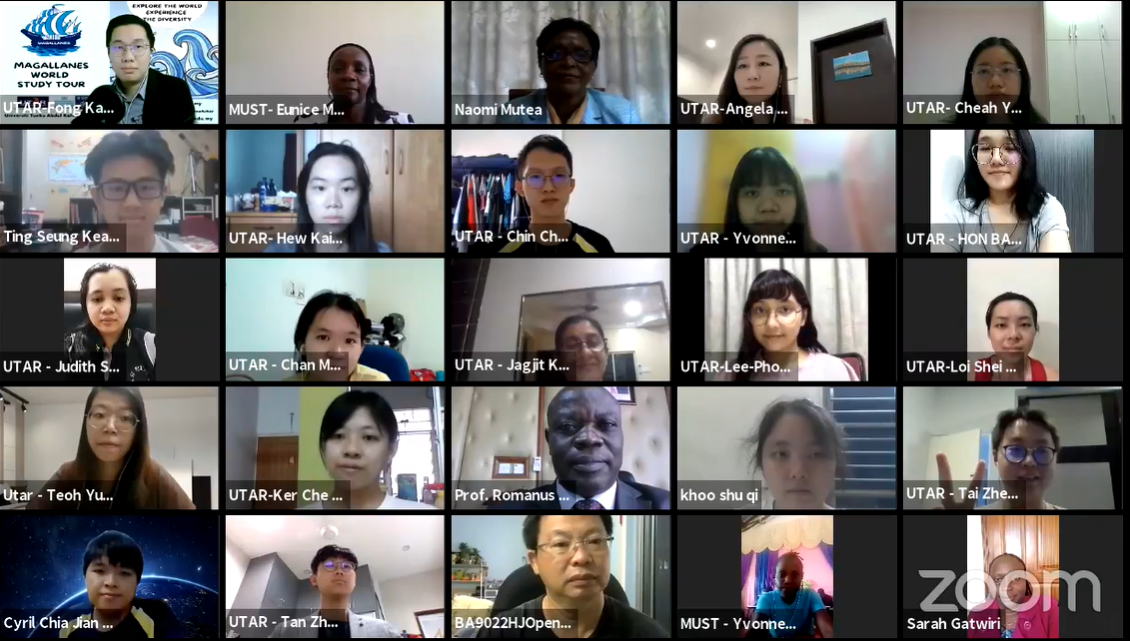
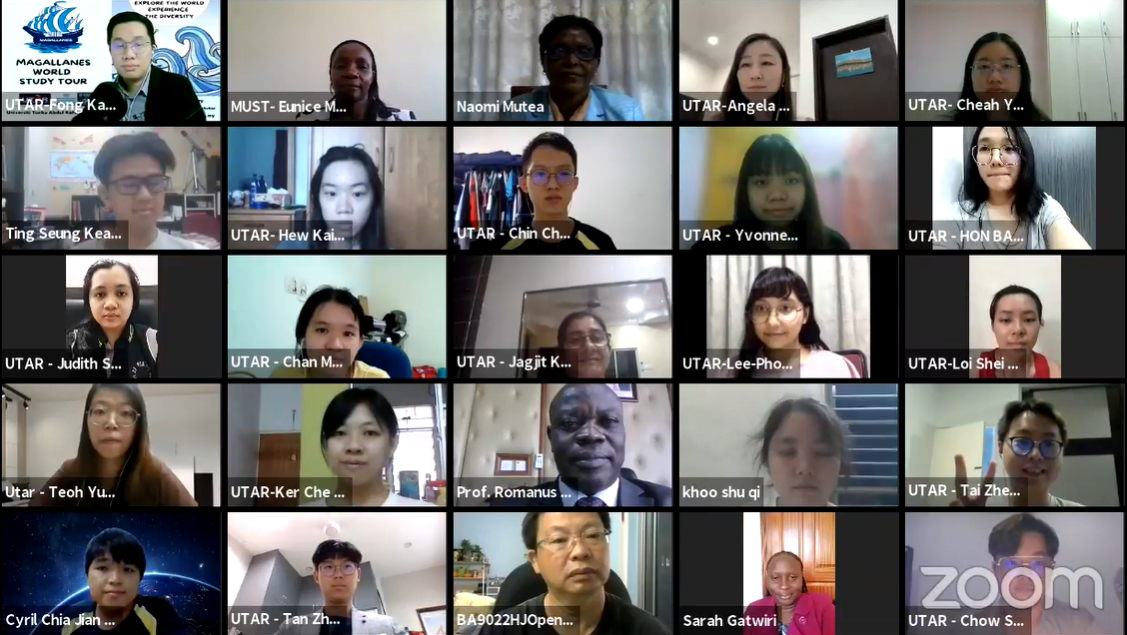
Group photograph after the end of the virtual study tour
Station 4: King Mongkut’s University of Technology North Bangkok, Thailand
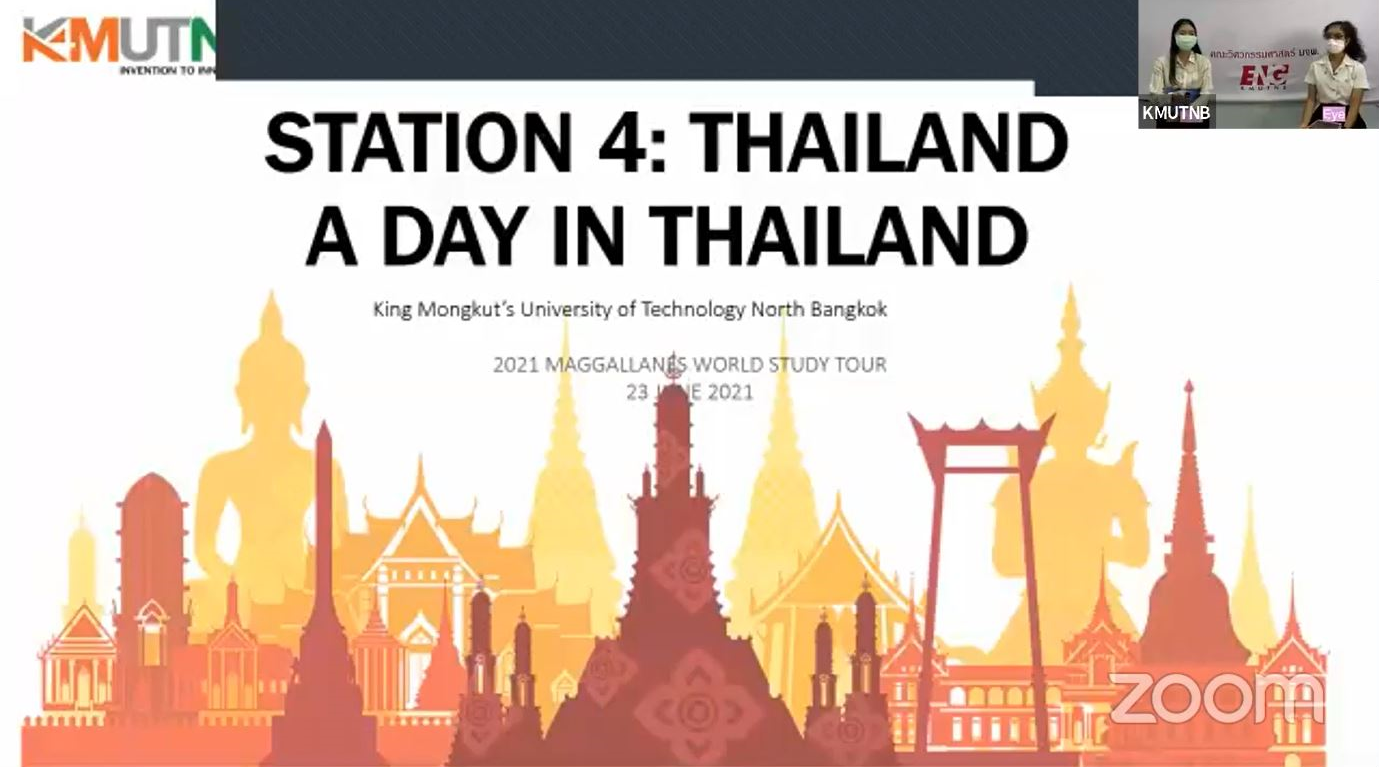
Station four of the virtual “Magallanes World Study Tour” headed to King Mongkut’s University of Technology North Bangkok (KMUTNB), Thailand on 23 June 2021, via Zoom. The event saw more than 250 participants from UTAR, KMUTNB and other partner universities.
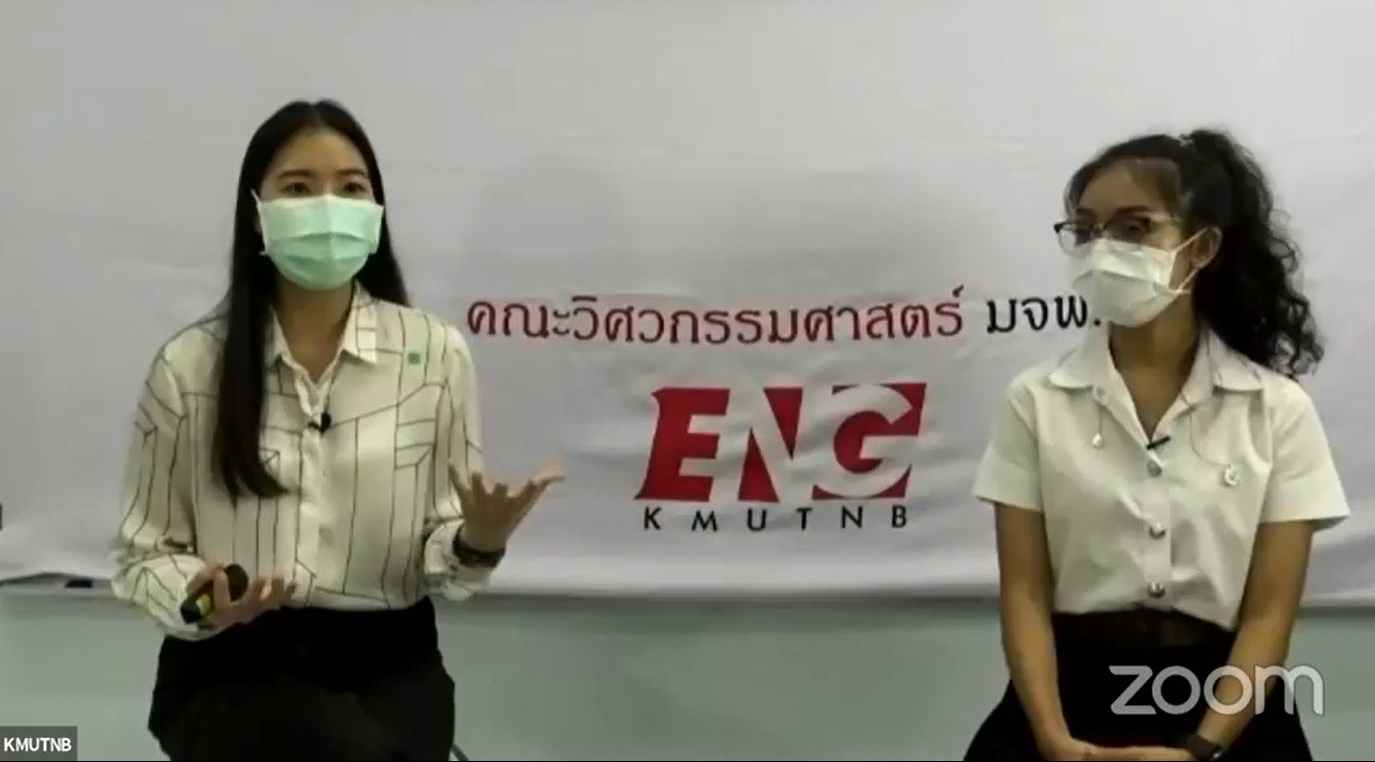
Dr Tanaporn Rojhirunsakool (left) and Nichakan Panichkul
Leading the virtual tour of Thailand was Director of Center for International Engineering Programs (CIEP), Faculty of Engineering, KMUTNB Dr Tanaporn Rojhirunsakool and student Nichakan Panichkul (Eye).
The virtual tour started with a sharing on “A Day in Thailand”. A fun-fact quiz about Thailand was conducted by Dr Tanaporn and Eye, to test the participants’ understanding of Thailand. Topics of the quiz included geography, food, symbols, taboo and many other general knowledge related to Thailand.
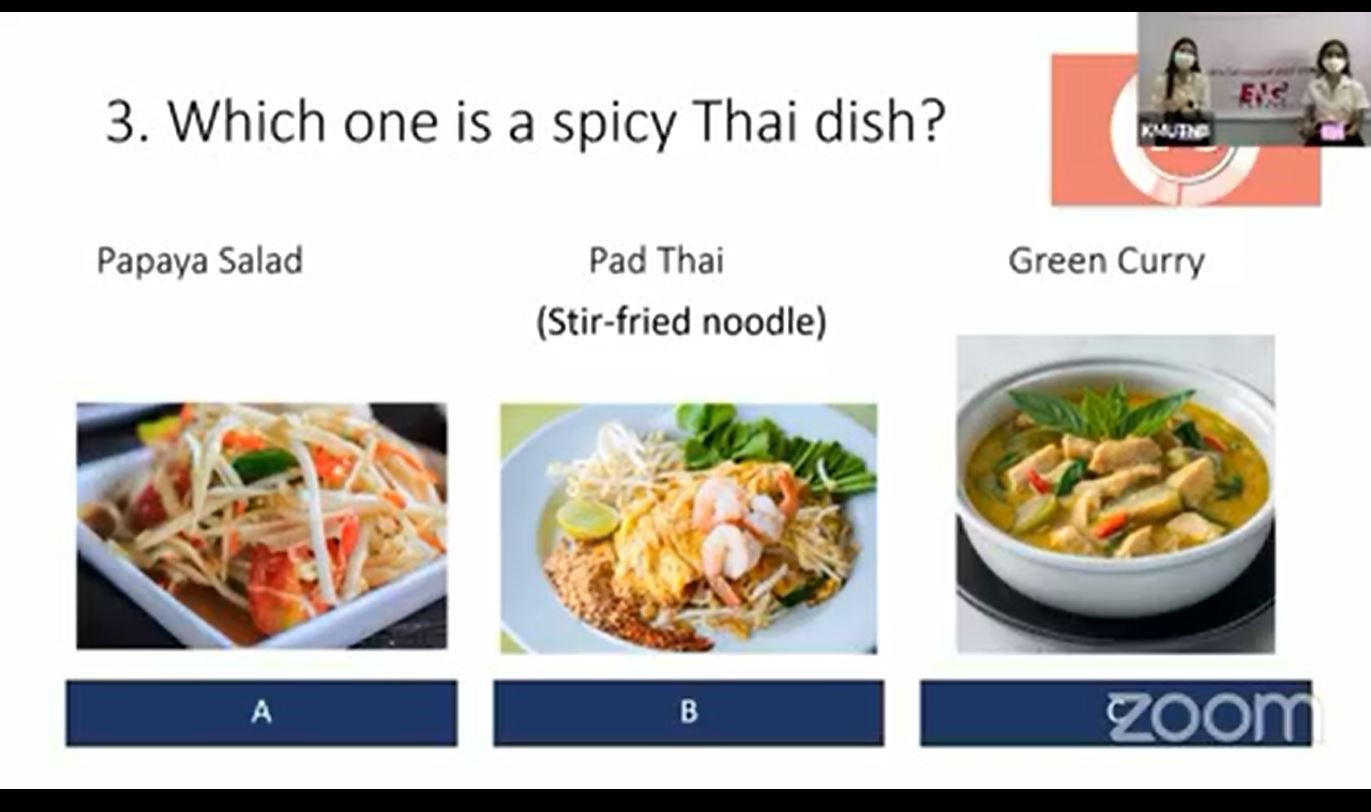
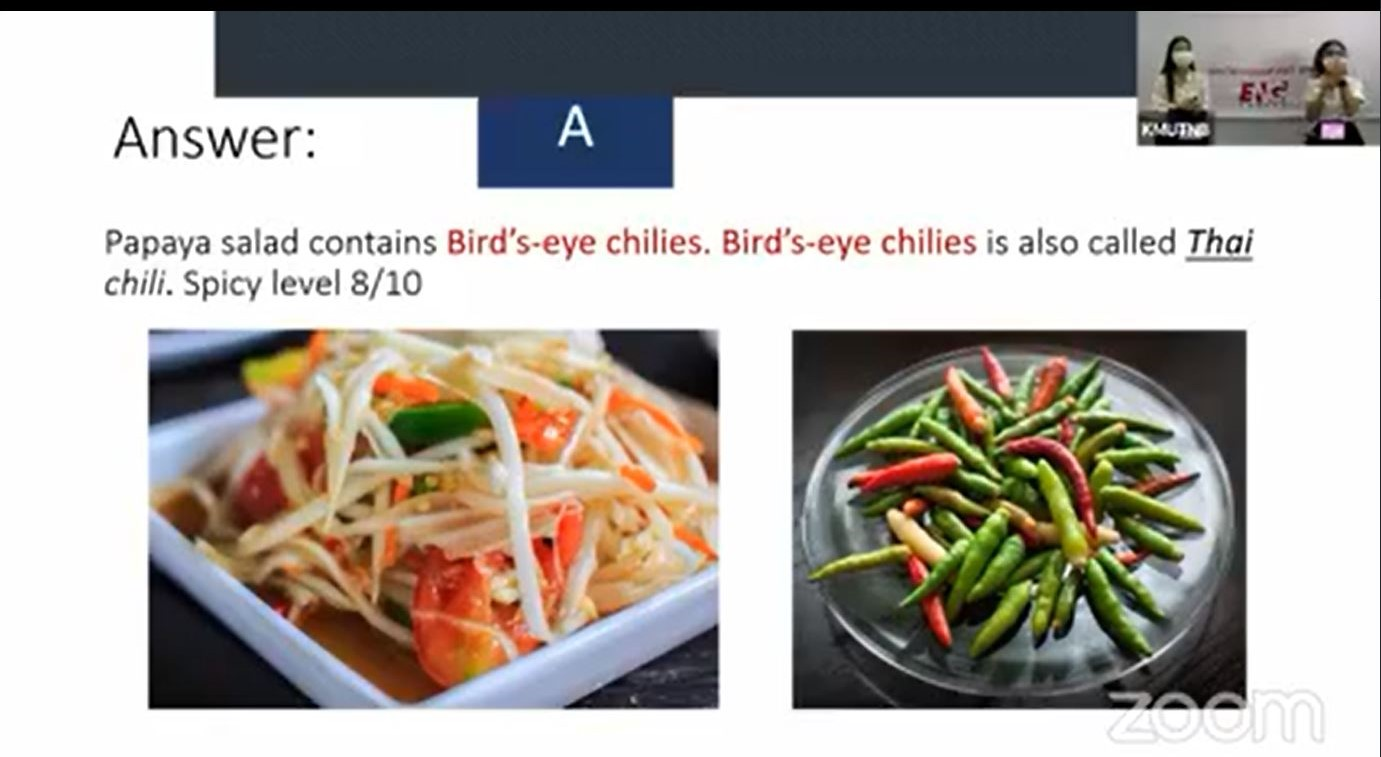
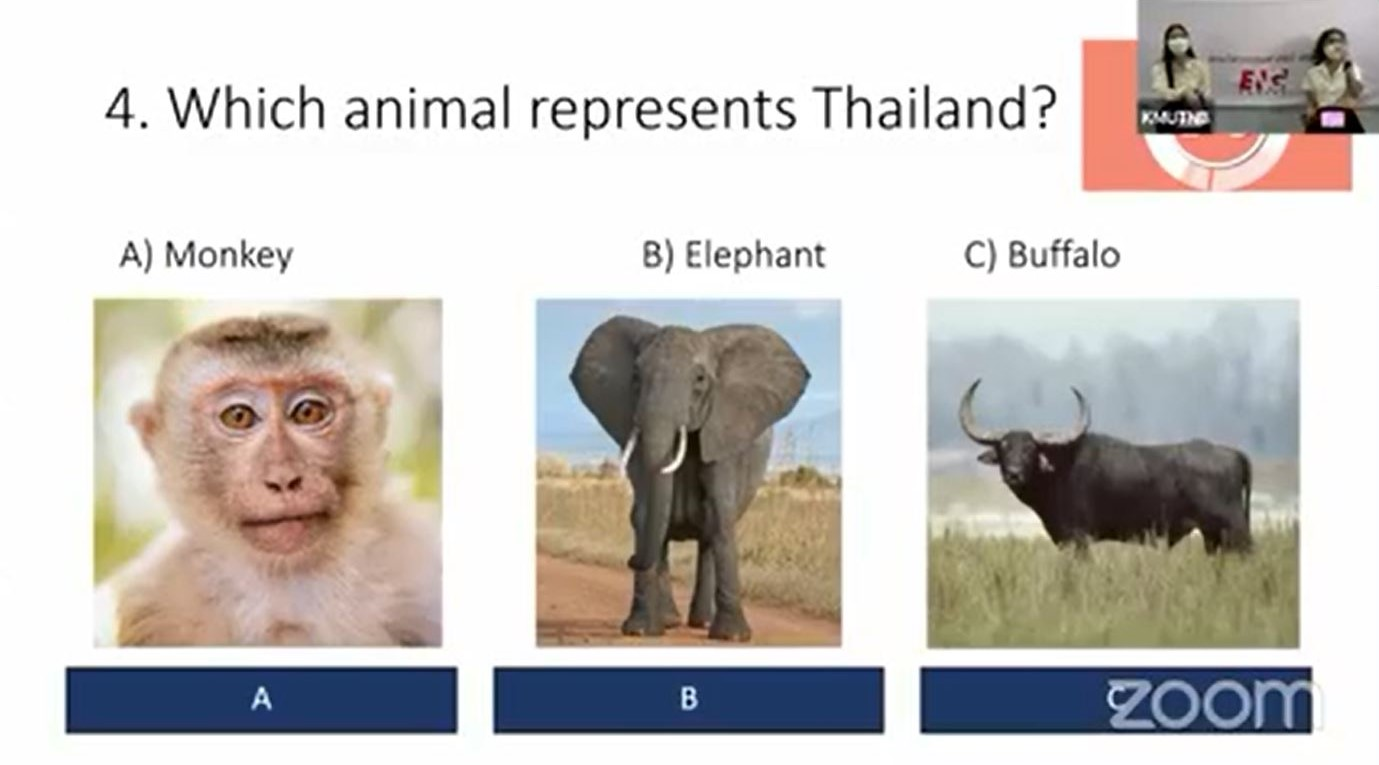
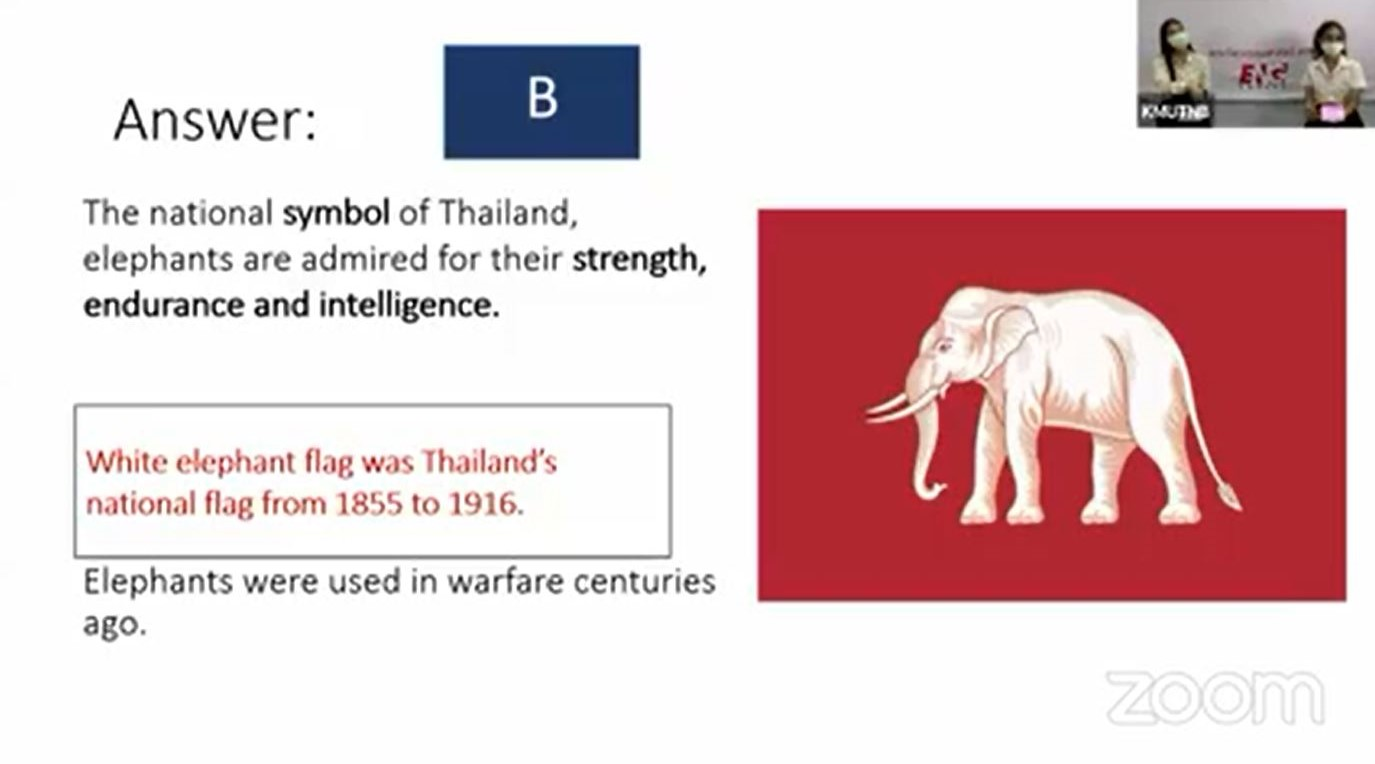
Participants gaining general knowledge of Thailand through the fun facts quiz
Dr Tanaporn made a brief introduction of Thailand and said, “Thailand is officially known as Kingdom of Thailand. It is the 50th largest country in the world. Thailand has also the world’s 20th largest population with approximately 69 million people. Thailand is the country with majority Buddhists among the country's population (95%). There are four regions (Northern, Northeastern, Central and South) in Thailand. Bangkok is the capital and most populous city in Thailand and a province in the central region.”
She then shared about the festivals in Thailand, such as Songkran Day (Water Festival), to celebrate the beginning of the Buddhist New Year; Loy Krathong Festival, to pay respects to the goddess of water; and Phi Ta Khon Festival, the biggest attraction to the otherwise sleepy farming village of Dan Sai, nestled in the mountains of Loei, in the province of Northeastern of Thailand. Festival celebration videos were also shared during the presentation.
Following was the presentation on attractive photos and videos, and the speakers led the participants to join the virtual tour to several tourist attractions in Thailand from Northern, Northeastern, Central and South regions, namely Chiang Rai, Chiang Mai, Su Rin, Nakhon Phanom, Ayutthaya, Bangkok, Ko Phi Phi, Railay and Hua Hin.
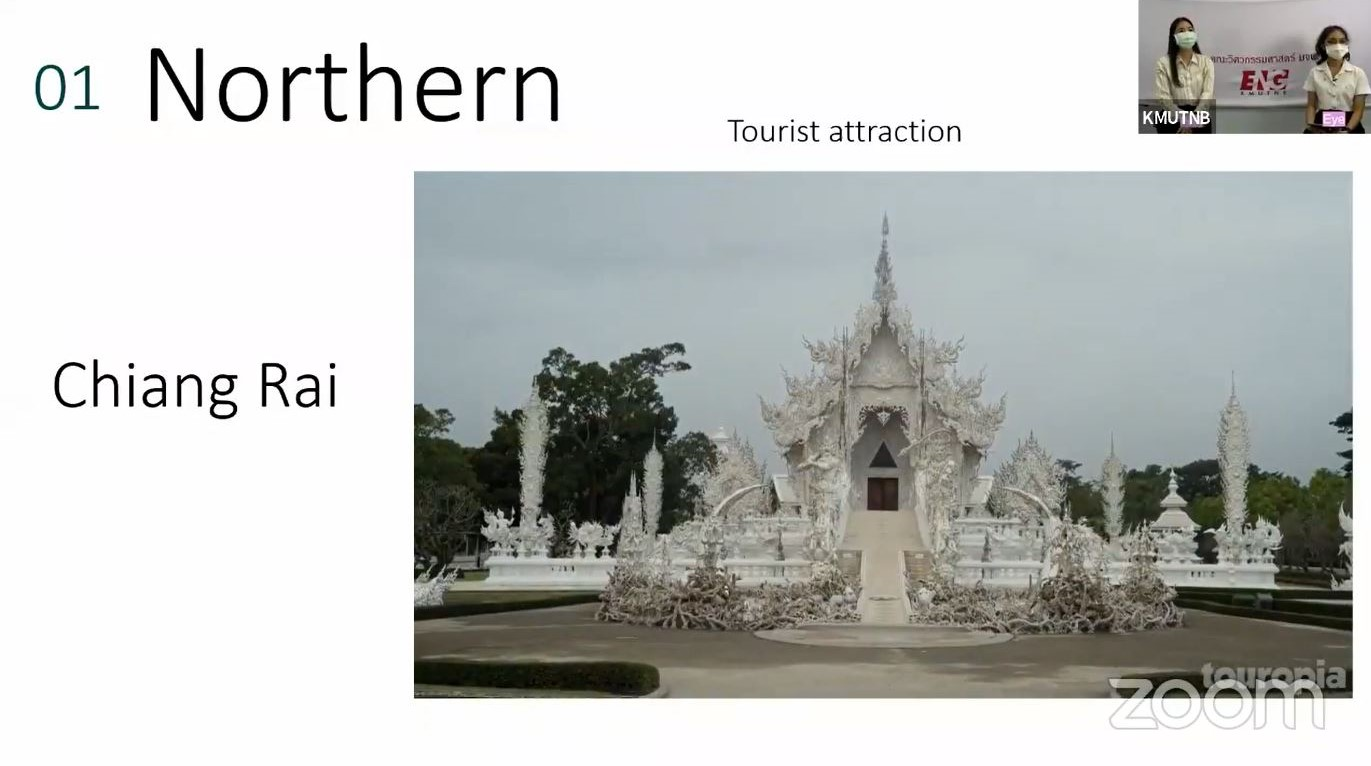
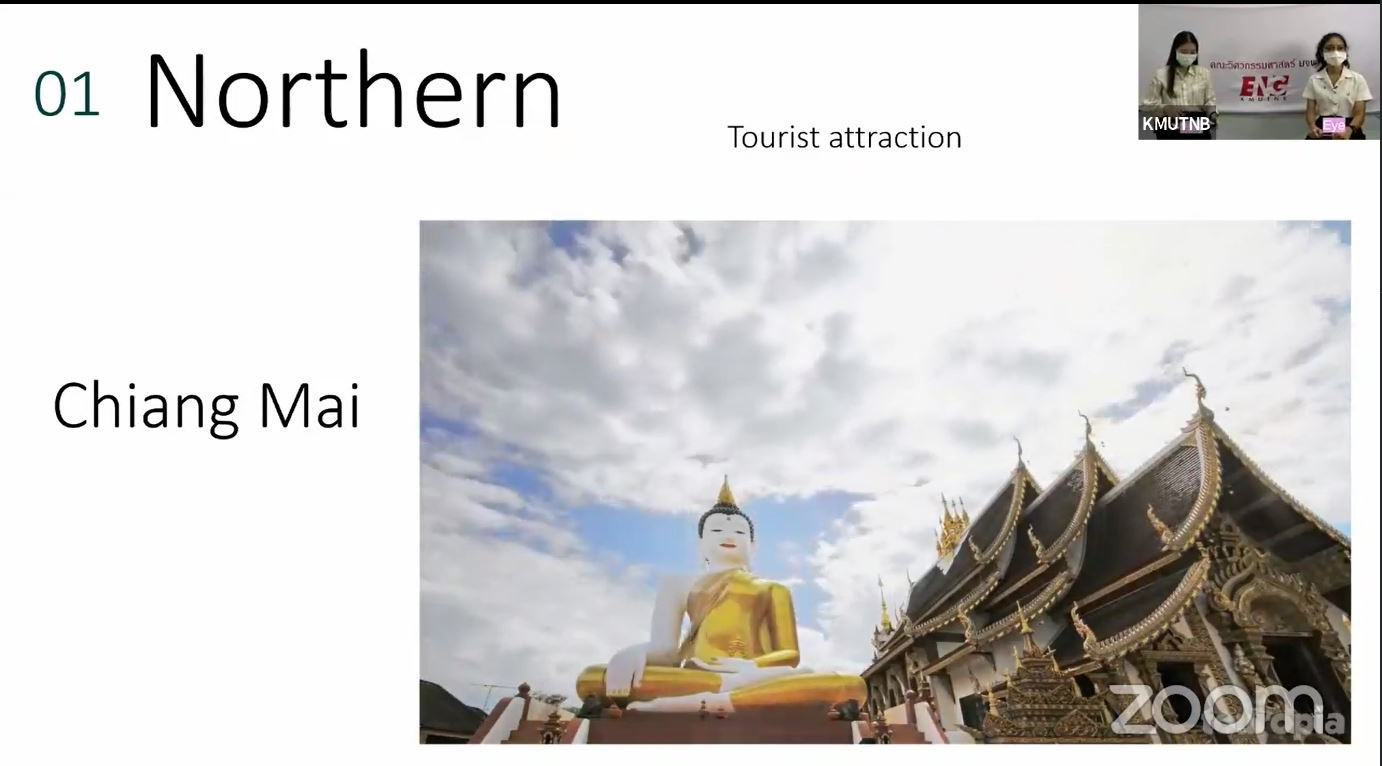
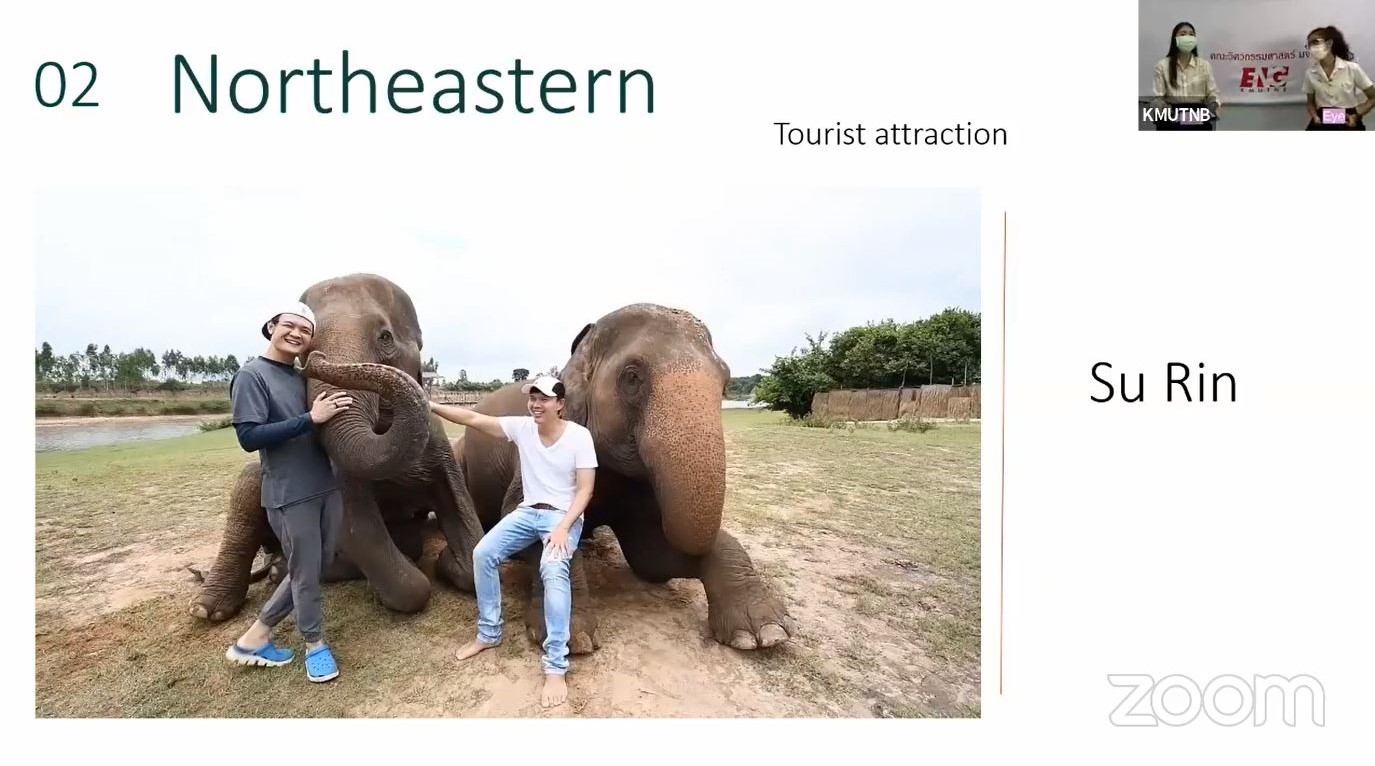
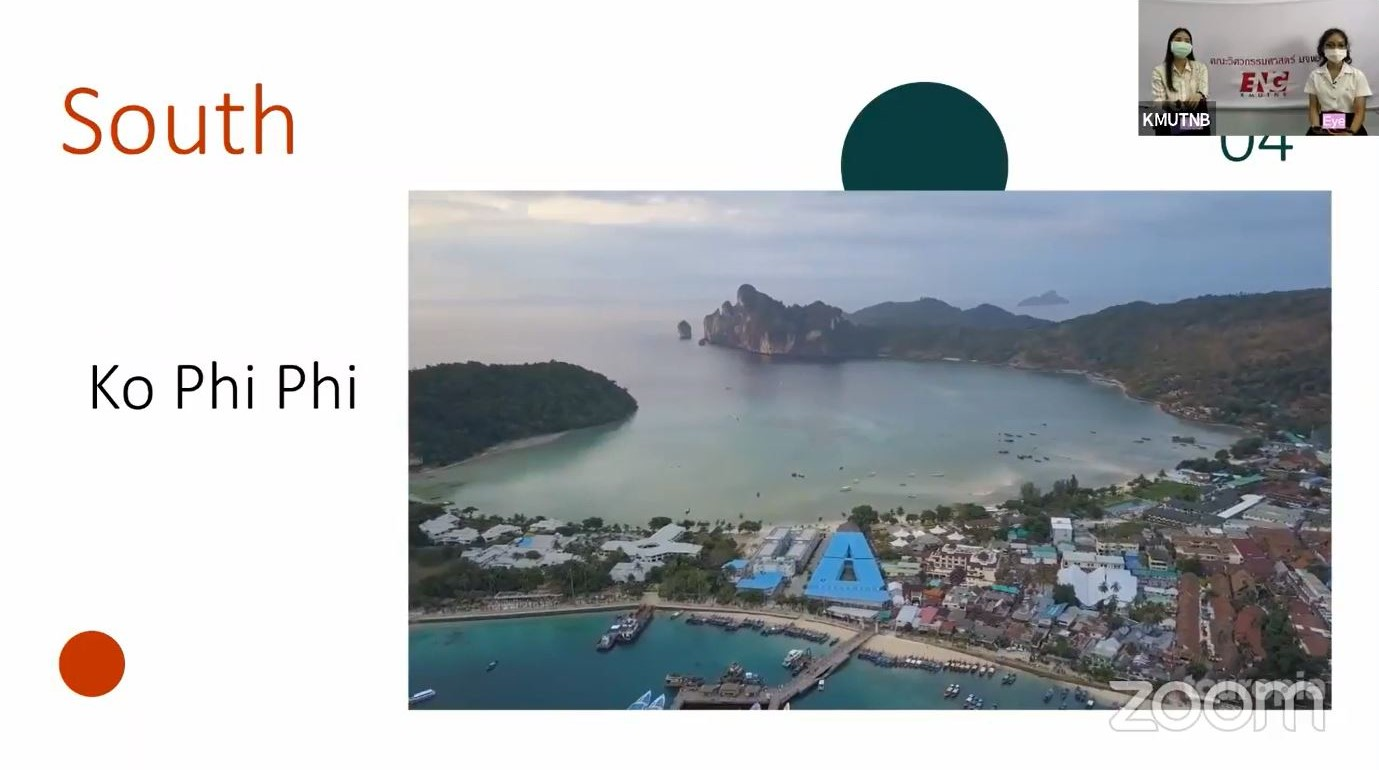
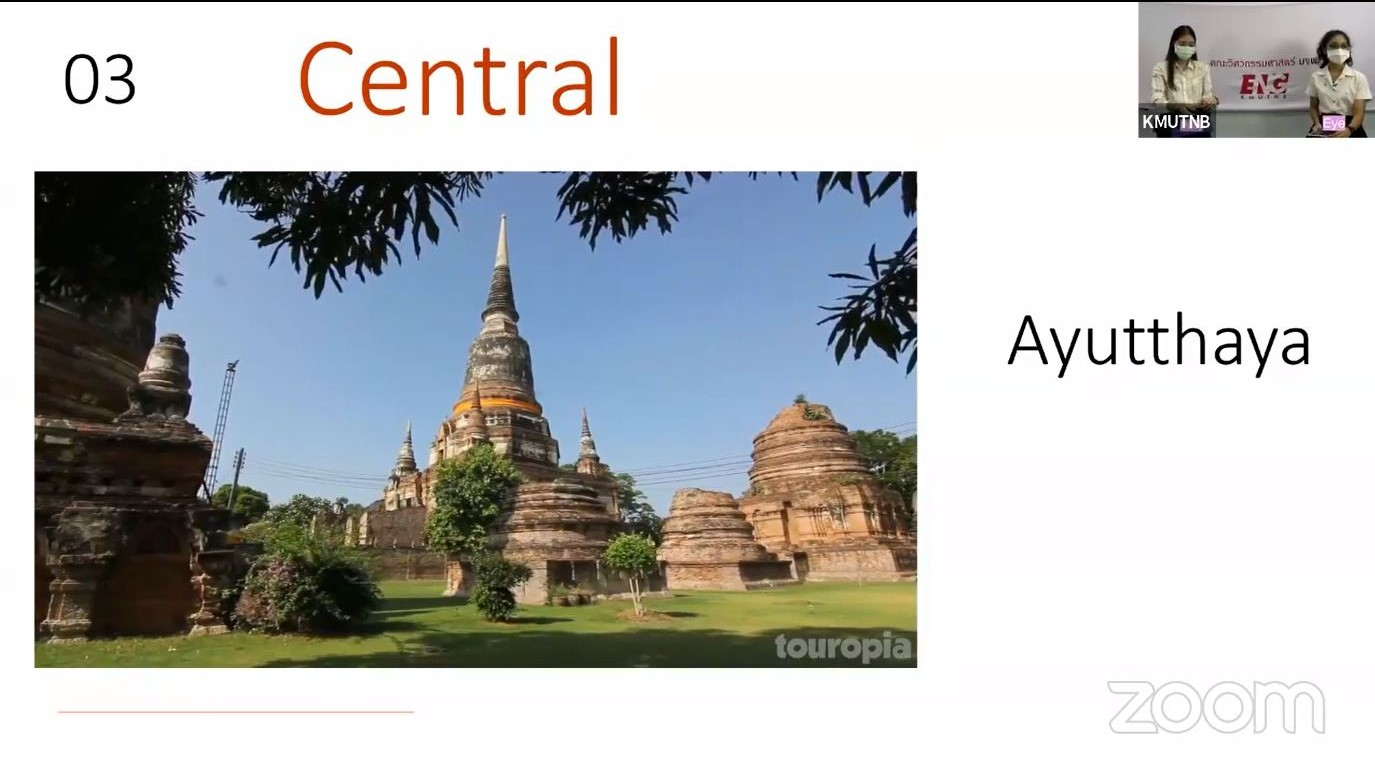
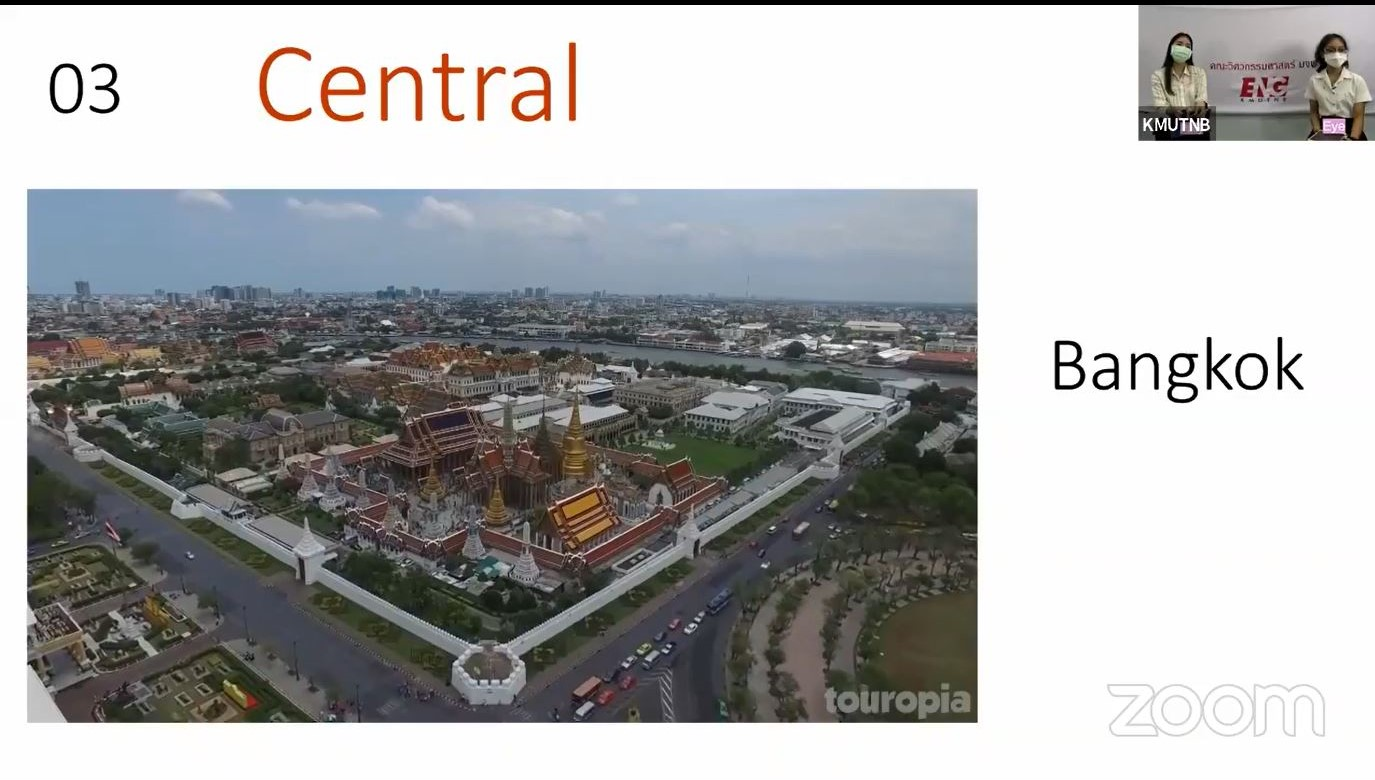
Participants visiting several famous tourist attractions in Thailand virtually
During the introduction on Thai’s best street food, Eye demonstrated the making of papaya salad (som tum). Papaya salad is a form of spicy Thai salad that comes from the Isaan province. Eye said, “Papaya salad is a simple recipe. It is easy to prepare. You only need 10 minutes to prepare it.”
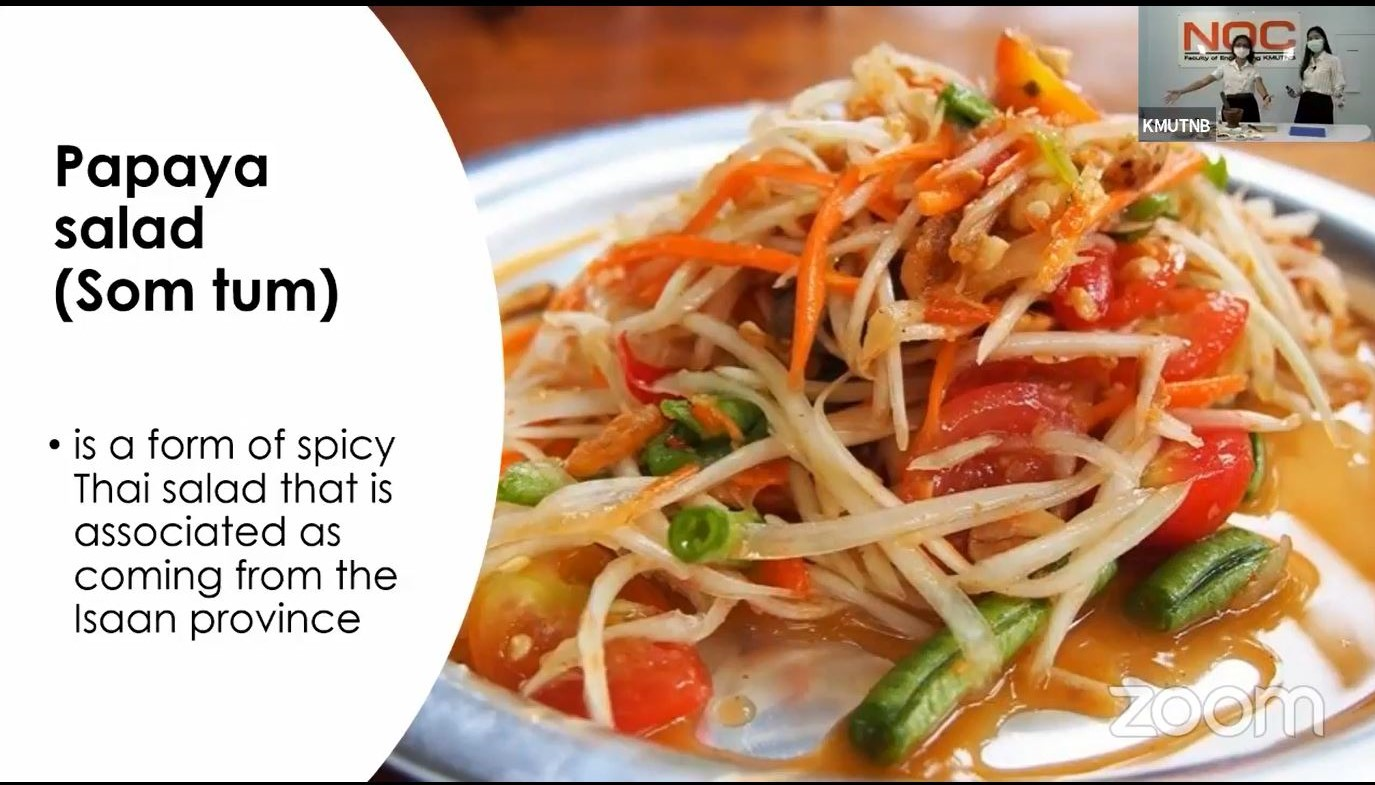

The recipe for papaya salad
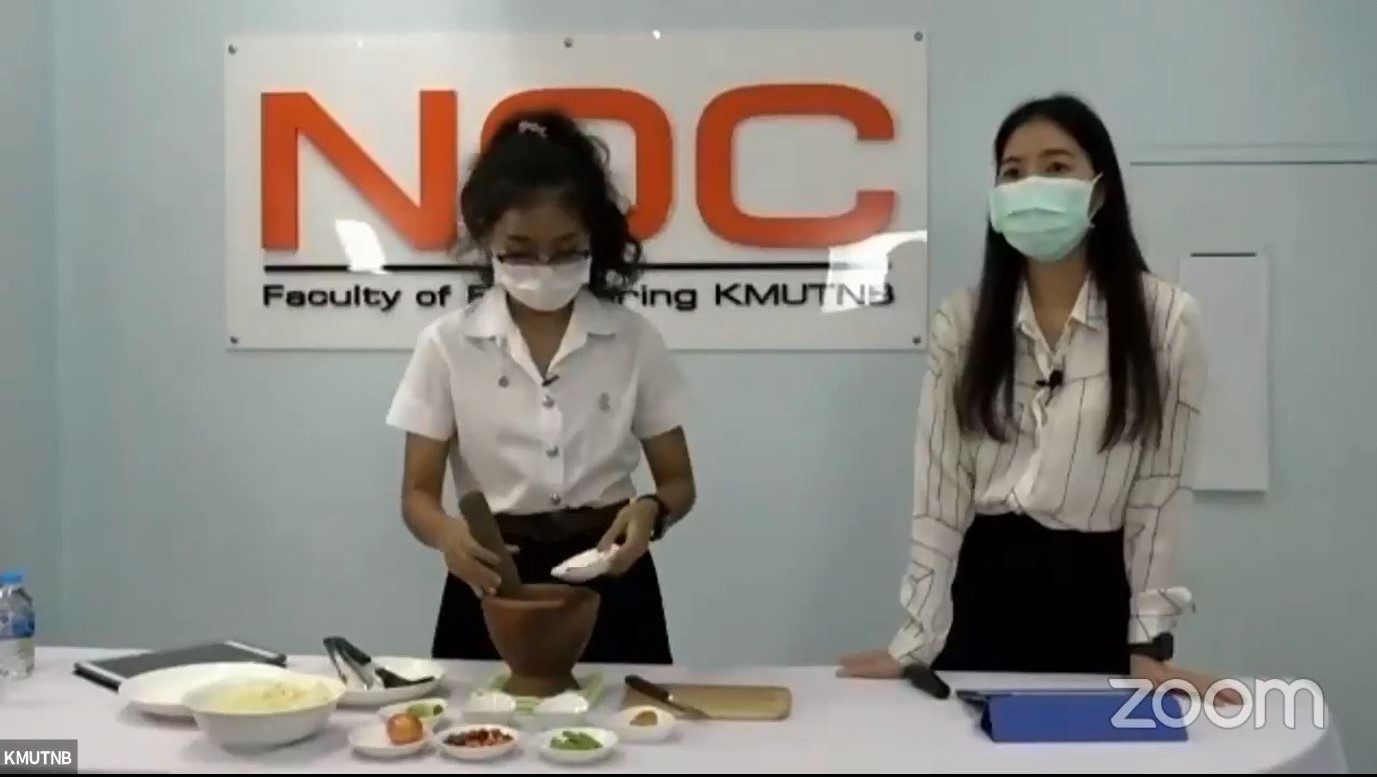
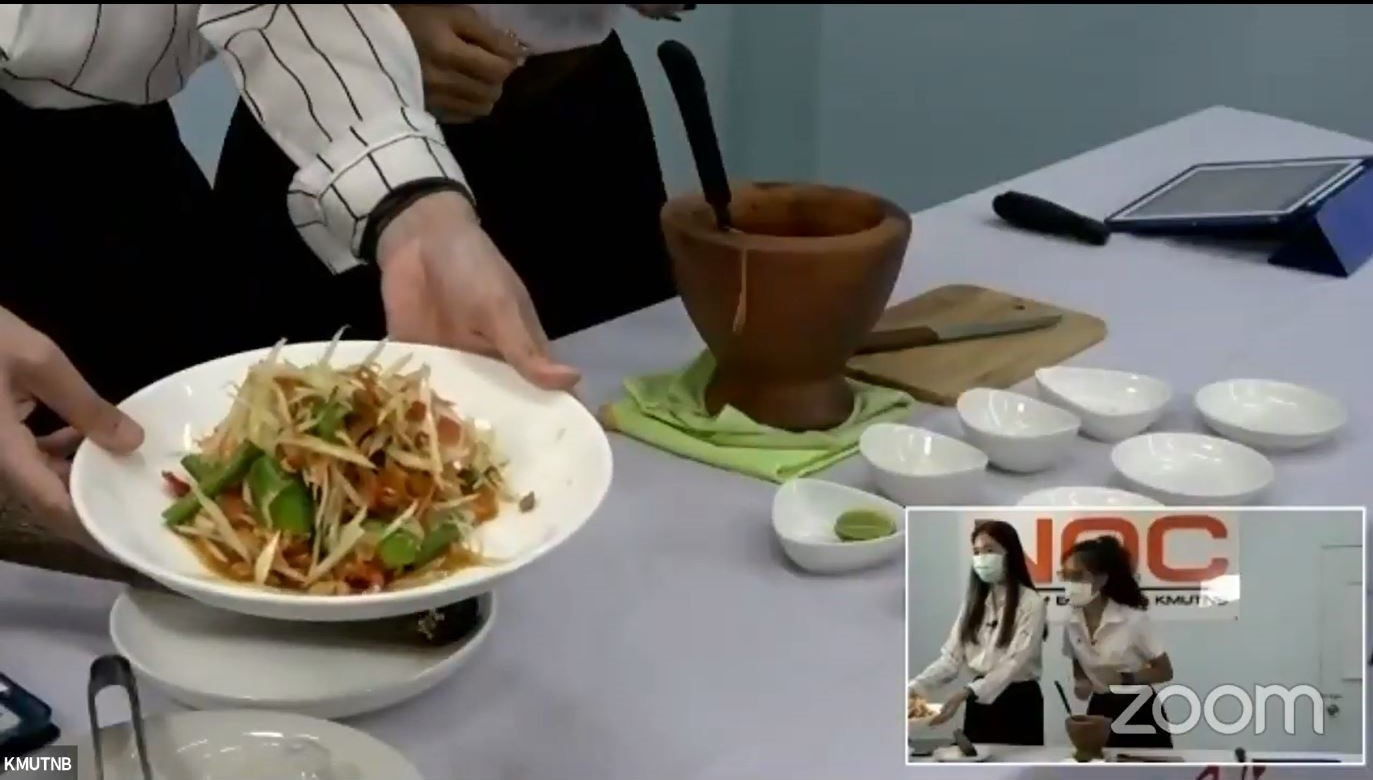
Eye (left) demonstrating the making of papaya salad, while Dr Tanaporn helps on
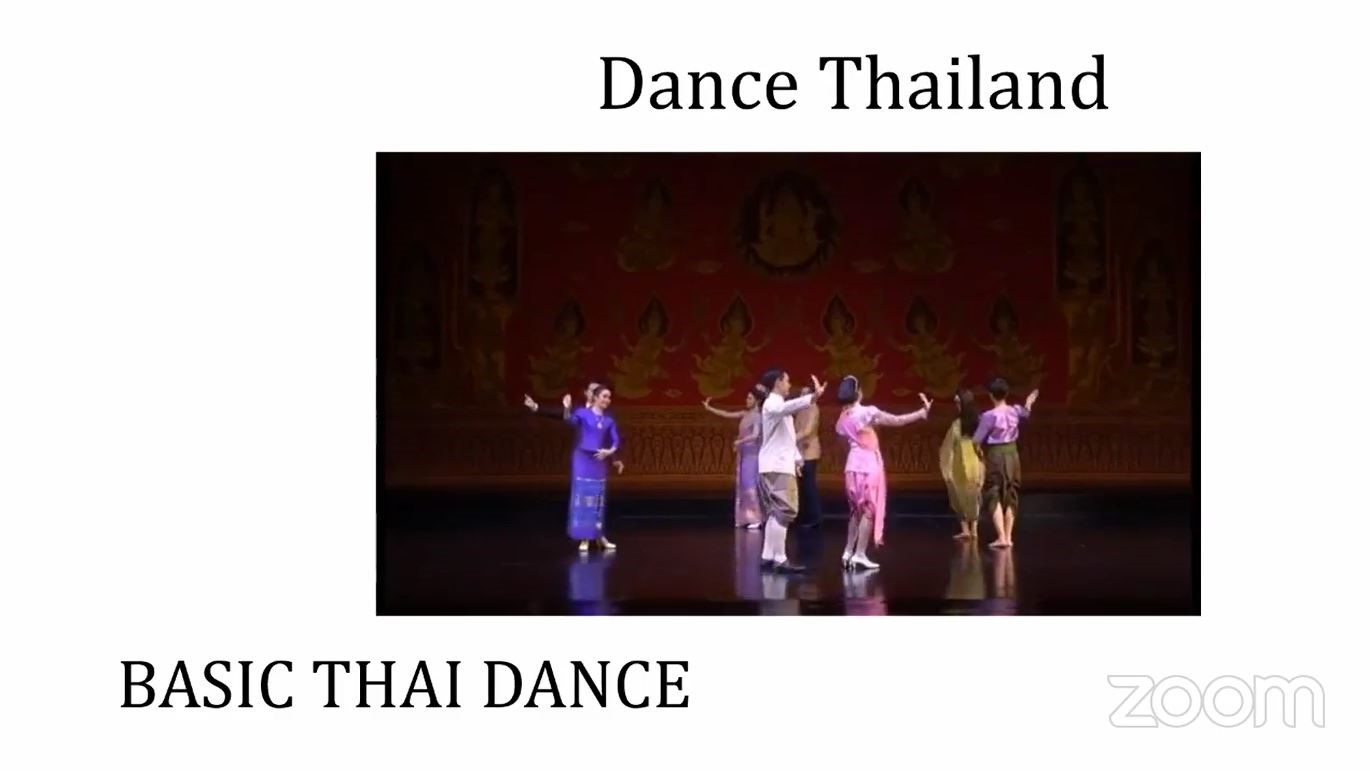
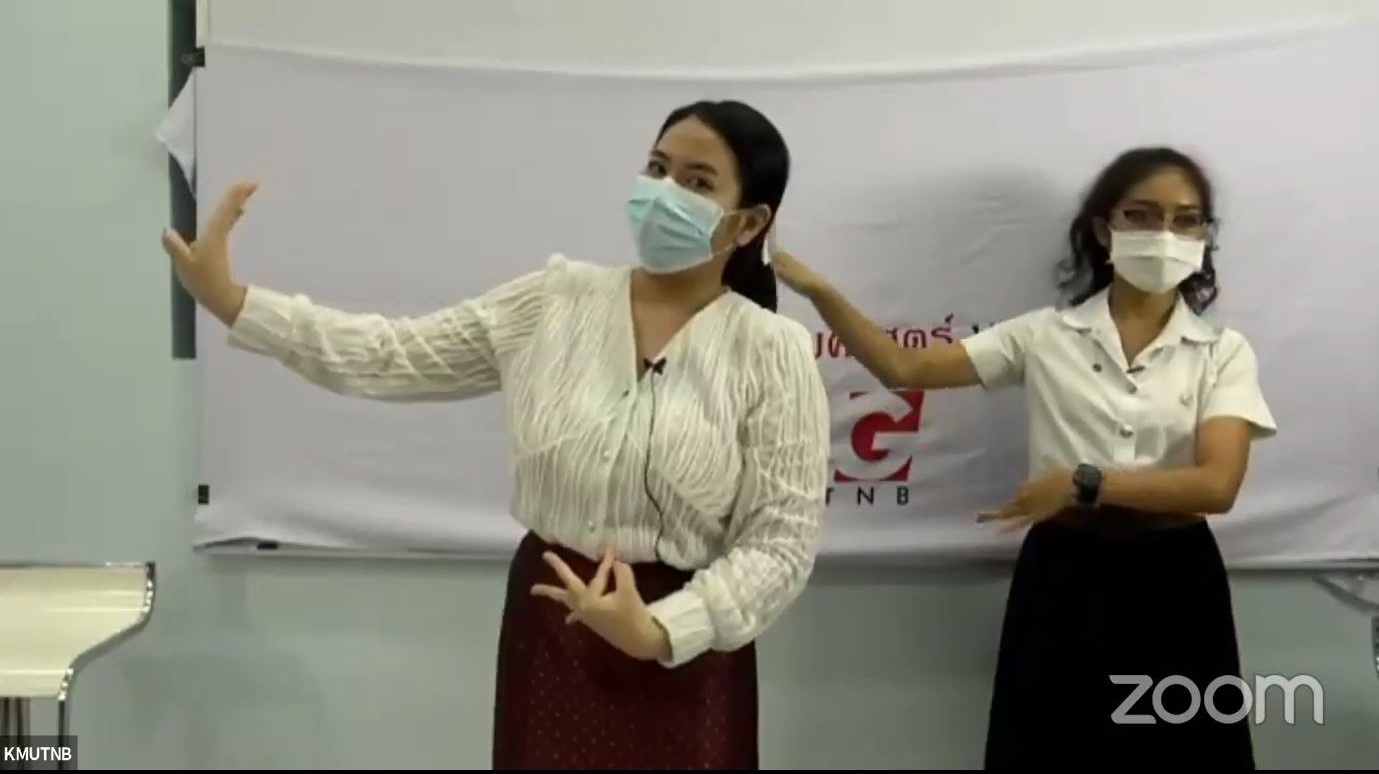
The demonstration on basic Thai dance came after the demonstration of food preparation
Later on, a presentation focusing on traditions, new cultures and co-existing cultures was presented. Titled “Thai Words, Thai Way”, the presentation focused on the aspects of things and tools, relaxation activities, unexpected dishes, ways of life, and resources and discoveries. It was an eye-popping presentation for participants as they learnt knowledge that most people did not know about Thailand.
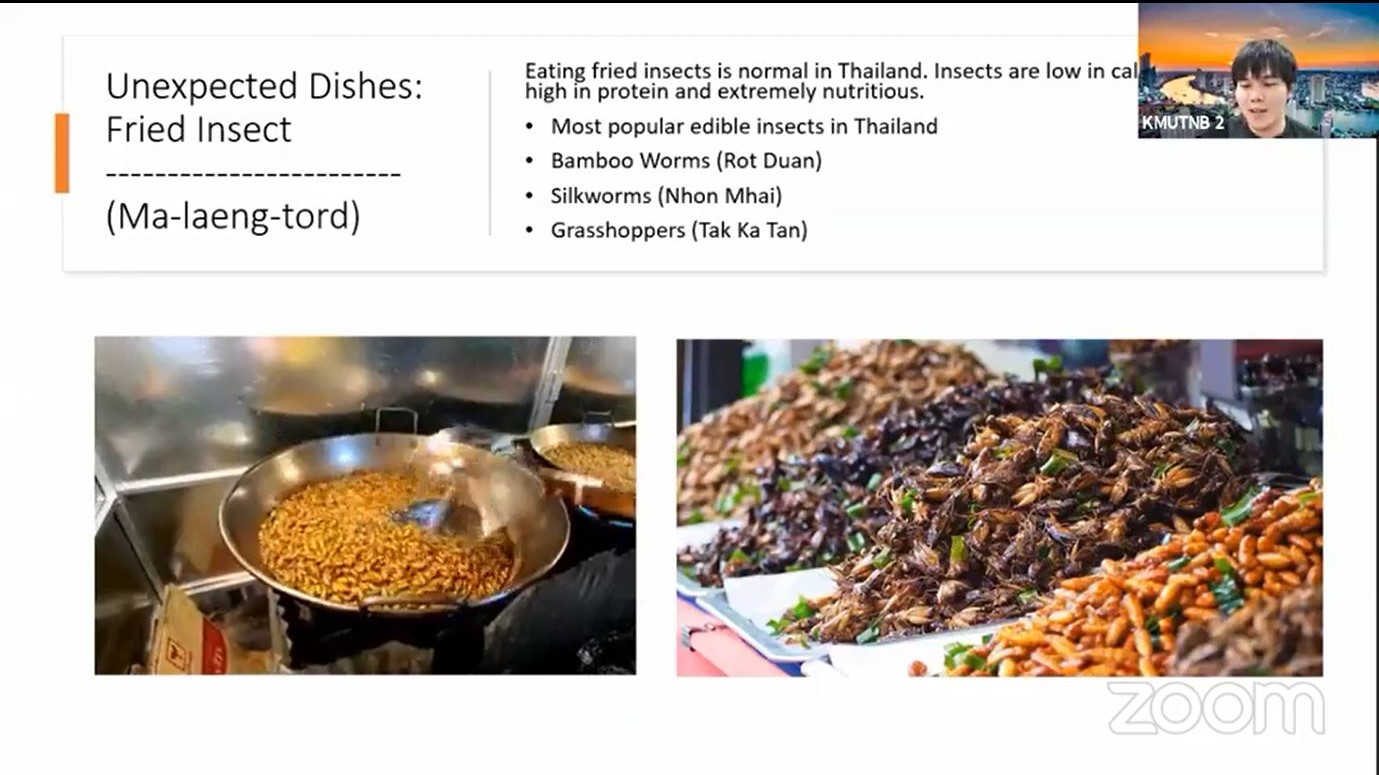
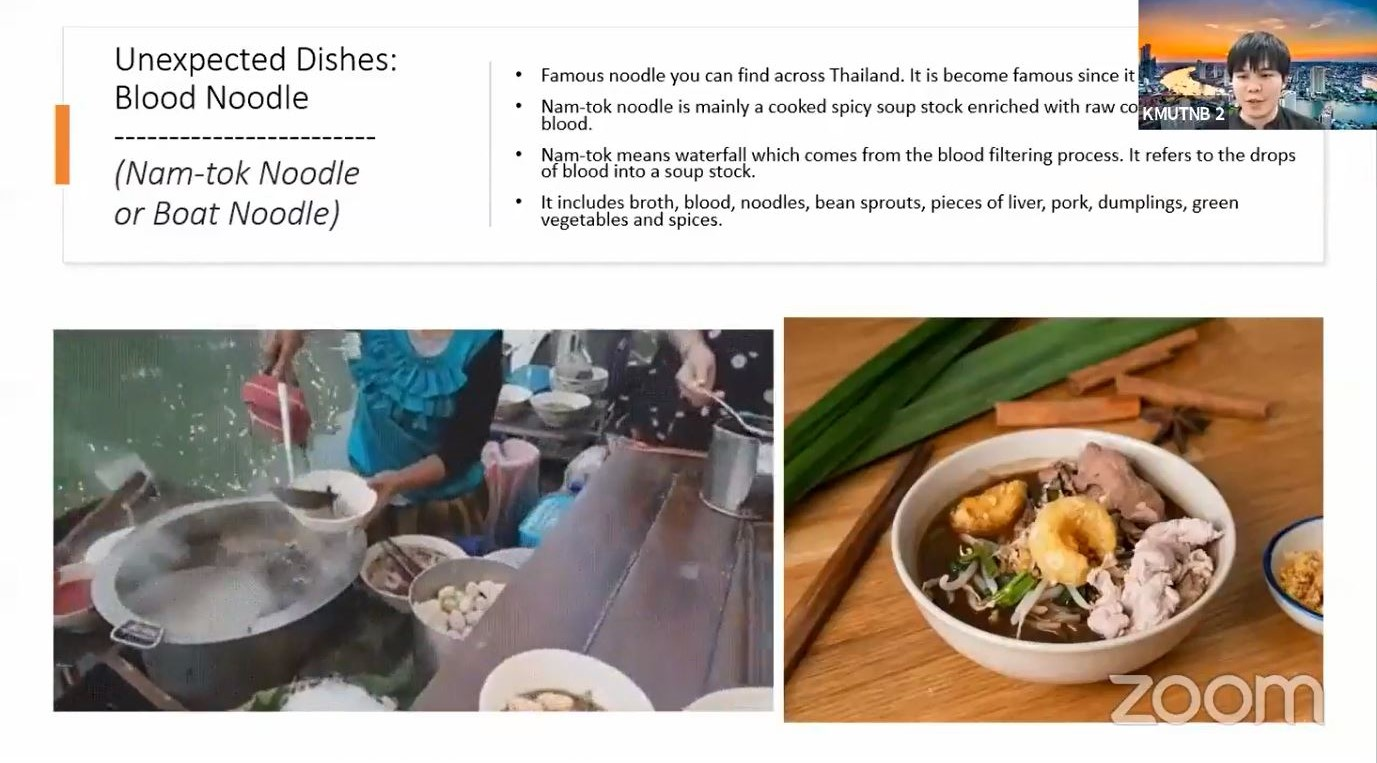
Fried insect and blood noodle are famous food in Thailand
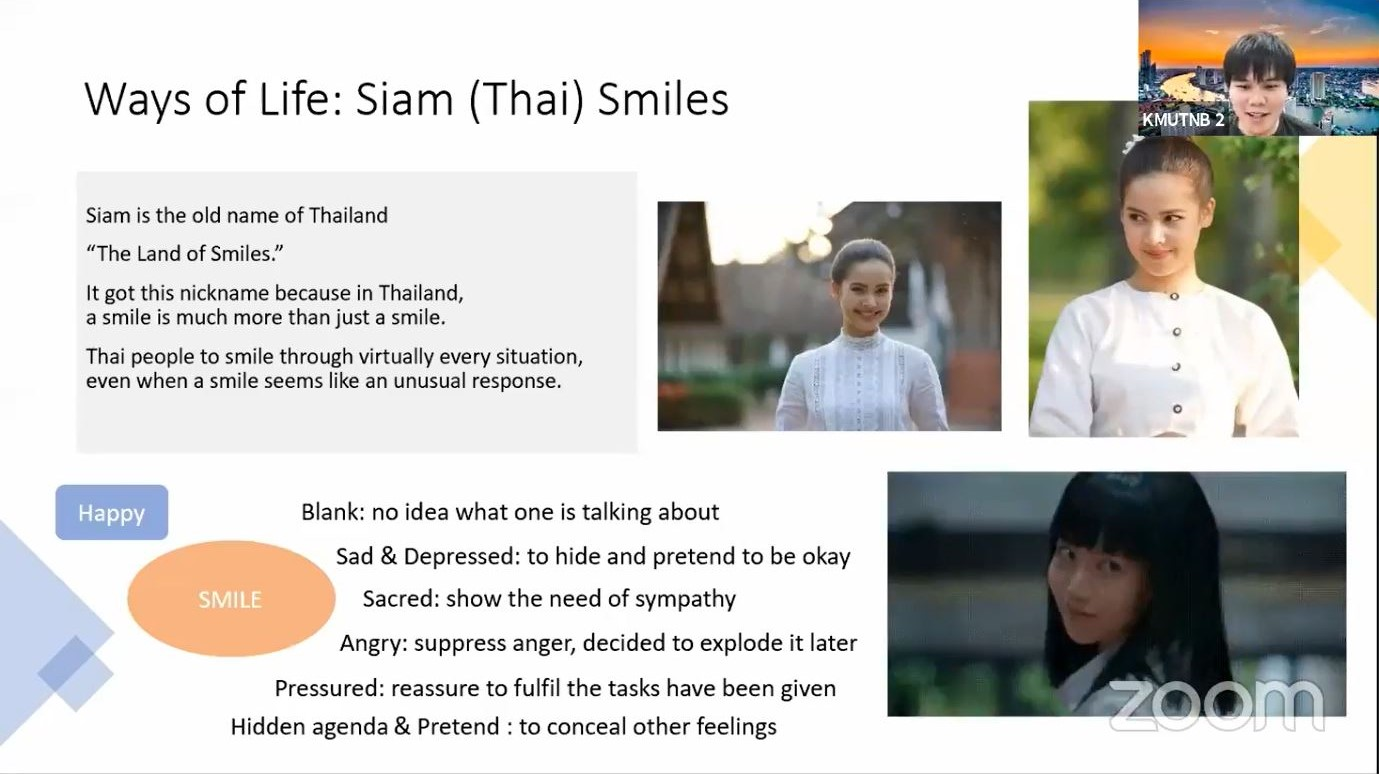
“A smile is much more than just a smile” is a unique culture in Thailand
There was also a virtual visit to KMUTNB Faculty of Engineering. The speakers introduced the establishment, historical background, campuses, faculties, programmes, achievements, and researches conducted in KMUTNB.
During the Q&A session, the speakers discussed topics such as the differences between Chinese Buddhism and Thai Buddhism, etiquette advice for visiting Thai temples, the similar food culture between Malaysia and Thailand’s Southern region; student exchange and internship, programmes offered and key research projects in KMUTNB, to name a few.
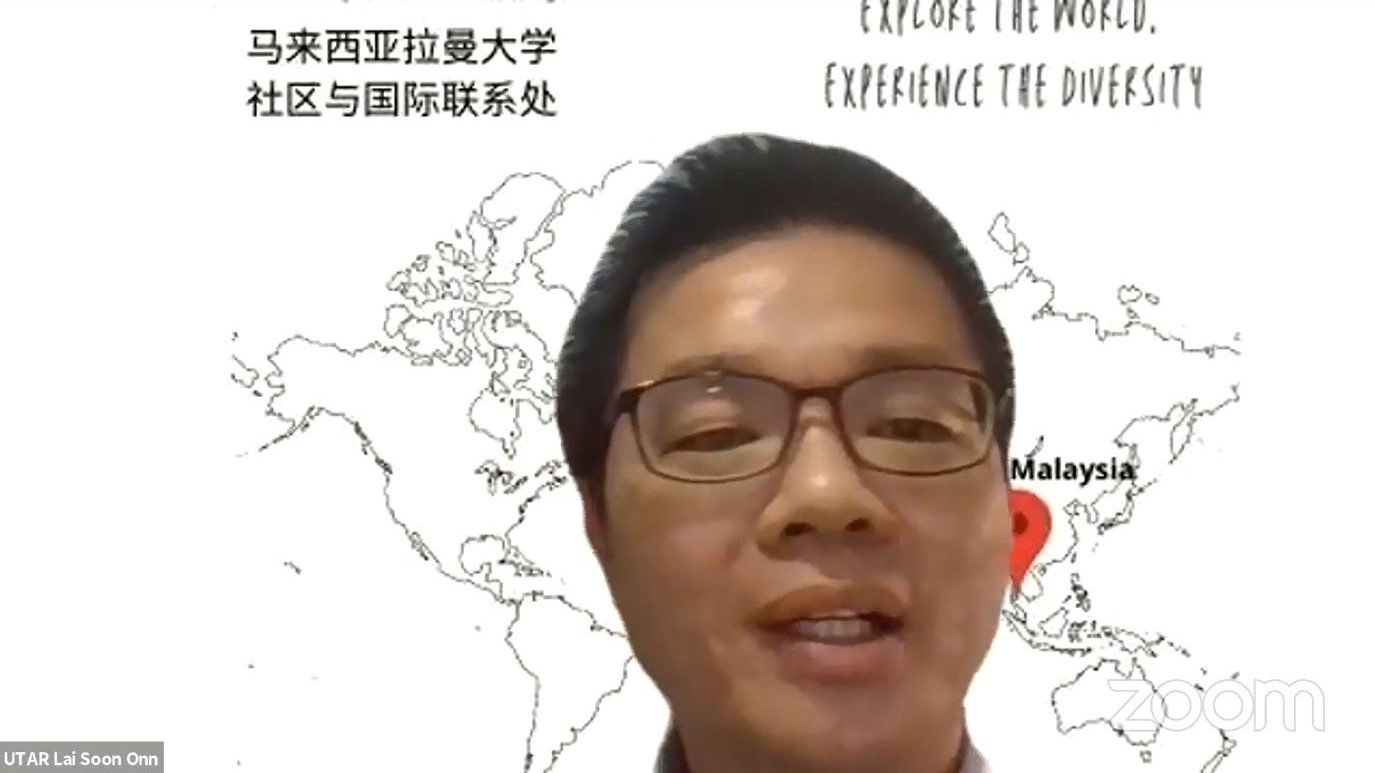
Dr Lai thanking KMUTNB for the preparation and students for the active participation
UTAR Division of Community and International Networking (DCInterNet) Director Assoc Prof Dr Lai Soon Onn thanked KMUTNB for its effort and students from UTAR, KMUTNB, as well as other institutions for their participation. He concluded, “The study tour conducted by KMUTNB covered Thailand's history, culture, geography, food, and many other things about the land of smiles. It provided students with a deeper understanding about Thailand which were not only limited to Thai’s food and tourist attractions. We hope participants have well-gained and enjoyed the virtual study tour. Lastly, we are looking forward to joining the physical study tour to KMUTNB when the pandemic is over.”
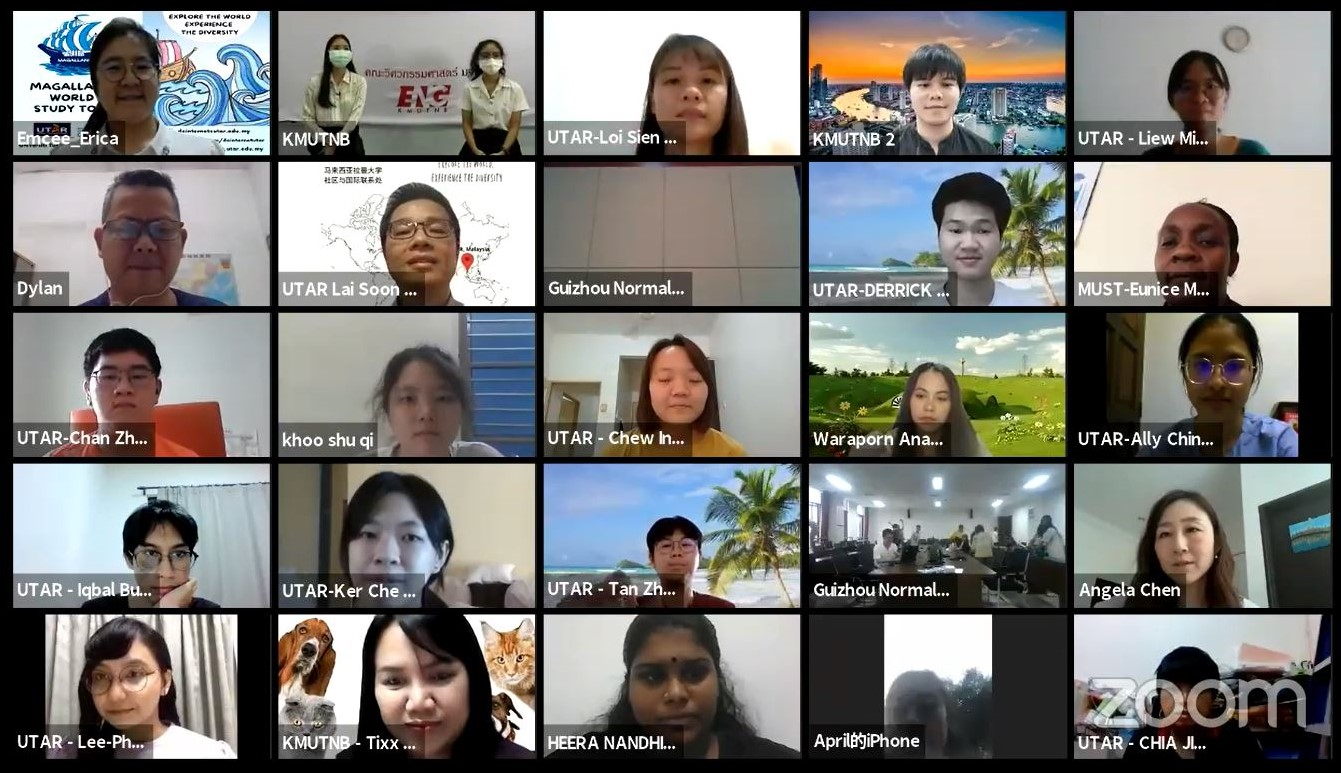
Participants from UTAR, KMUTNB and partner universities during the virtual “Magallanes World Study Tour”
Station 5: Guizhou Normal University, China
.png)
Group photography session among participants
The first session focused on the rapid
development of China in the recent years with the building of big data
platform and the development of online tourism and other industries. In the
second part, student Yong Zhi Yu spoke about the basic situation of Guizhou
province, Five-hundred-meter Aperture Spherical Telescope (FAST) and the
minority culture of Guizhou province, Guizhou’s cuisine and the current
development of Guizhou.
Then, participants were given a brief
introduction about GZNU and the scholarship policy for international
students. Apart from that, participants learnt about GZNU’s China-ASEAN
culture study centre, building of big data and the minority cultural
curriculums.
“Big data has the ability to calculate
our interests and characteristics and help us collect the information so we
can receive it more effectively. 5G improves the perception of “Internet of
People” by increasing the connection rate, while encouraging human beings to
create data. 5G also serves more for “Internet of Things”. The strength of
all communication infrastructures is paving their way for the rise of big
data,” said Yong.
.png)
GZNU international student exchange
programme
She then shared a video on
international big data expo 2021 to share the experience of some frontier
technologies based on big data which have been used in every aspect of their
daily lives. She also shared some major virtual travel websites which
included City Bar, China Virtual Travel Network, Panorama, AMET and The
Palace Museum.
“Guiyang is the capital city of
Guizhou and the total area is 176 167 km2. The population is about 38, 562,
148. Its ethnic composition is comprised of Han, Miao, Buyei, Dong, Tujia,
Yi, Gelau and Sui. Guizhou is a mountainous province which lies at the
eastern end of the Yungui Plateau. At 2,900 m above sea level, Jiucaiping is
Guizhou’s highest point. South China Karst is one of the world’s most
spectacular examples of humid tropical to subtropical karst landscape. It is
a serial site spread over the provinces of Guizhou, Guangxi, Yunnan and
Chongqing and it covers 97 125 hectares,” said Yong.
Yong added, “Compared to other
provinces of China, Guuzhou has not benefitted substantially from the
Chinese economic reform, but the unique natural, cultural and environmental
resources are Guizhou’s advantages, especially in tourism.”

A virtual tour on “A Panorama of
Rivers and Mountains”
.png)
.png)
Yong explaining the minority ethnic’s
culture
Station 6: University of
West Attica, Greece

The poster
Inspired by Ferdinand
Magellan, the first person to circumnavigate the globe, the sixth station of
the virtual “Magallanes World Study Tour” was conducted on 30 July 2021 via
Zoom with an attendance of 311 participants. The sixth station focused on
Greece.
University of West
Attica (UniWA) was invited to share about “Athens” to the participants.
Present to deliver the sharing was UniWA Department of Industrial Design and
Production Engineering lecturer Prof Dr Theodore Ganetsos. He was
accompanied by Assistant Professor Nikolaos Laskaris, PhD student
Konstantina Romantzi.
During the virtual
tour, Prof Theodore enlightened the participants with three interesting
sub-topics, namely “Introduction on UniWA”, “Culture- Celebration” and
“Student Life”.
Konstantina started
the sharing by presenting a welcome note by UniWA’s Rector Professor
Panagiotis E. Kaldis, “UNIWA operates with high educational and research
standards and strives to respond to the ever-increasing demands of the
modern society for the creation of executives that have attained a solid
scientific and technological background. Our vision is not only to be
established in our country, but also internationally as a first-choice,
modern, and progressive university, with a publicly recognised and
competitive role worldwide. Our strategy is to invest in people and our
practice is to co-operate with the academic community based on a system of
values, trust, stability and credibility with ethics and justice, providing
equal opportunities and applying the university’s meritocracy and
accountability to society. At the same time, we are encouraging the
intensification of digital transformation, innovation and academic
cosmopolitanism.”

Prof Theodore during the sharing
Prof Theodore then
introduced UNIWA and said, “UNIWA was founded in March 2018 by the National
Law 4521. The foundation of the newly established university came from the
merging process of the former Technological Educational Institute of Athens
and Piraeus University of Applied Sciences. In 2019, the National School of
Public Health joined the newly established university.”
“At UNIWA, there are
27 departments operating under the academic umbrella of six schools,
covering a wide range of scientific fields, such as social, administrative
and economic sciences, engineering sciences, health and welfare sciences,
food sciences, and applied arts and cultural studies. According to the
official data, UNIWA is the third-largest university in the country with
regard to the number of undergraduate students where it hosts over 50,000
students in total,” he added.
Prof Theodore
emphasised, “UNIWA is actively supporting Greece’s strong commitment for the
implementation of the United Nations 2030 Agenda for Sustainable Development
and its 17 SDGs as they provide an ambitious and transformative framework
for a new, fair and sustainable development path, which ensures a balance
between economic growth, social cohesion as well as protection of the
environment and the country’s unique ecological wealth. On the environmental
pillar key institutional priorities include the shift towards a low carbon
circular economy and improvement in waste reduction, reuse and recycle for
creating new jobs and increasing resource efficiency.”
He then spoke about
international collaborations which included Erasmus+, interstate
collaborations and cooperation protocols.
He introduced, “ERASMUS+ is the European Commission’s programme for
new education, training, youth and sport. It aimed at enhancing skills,
employability and modernising education, training and youth systems in all
areas of lifelong learning (higher education, vocational education and
training, adult education, school education, youth activities, etc.). The
action of the Erasmus+ programme in the field of higher education is
inextricably linked to the Erasmus programme. It grants mobility for
students and staff in higher education institutions of the participating
countries, including Erasmus+ studies, Erasmus Traineeship and Erasmus
International Credit Mobility.”


ERASMUS+ International Week at UNIWA
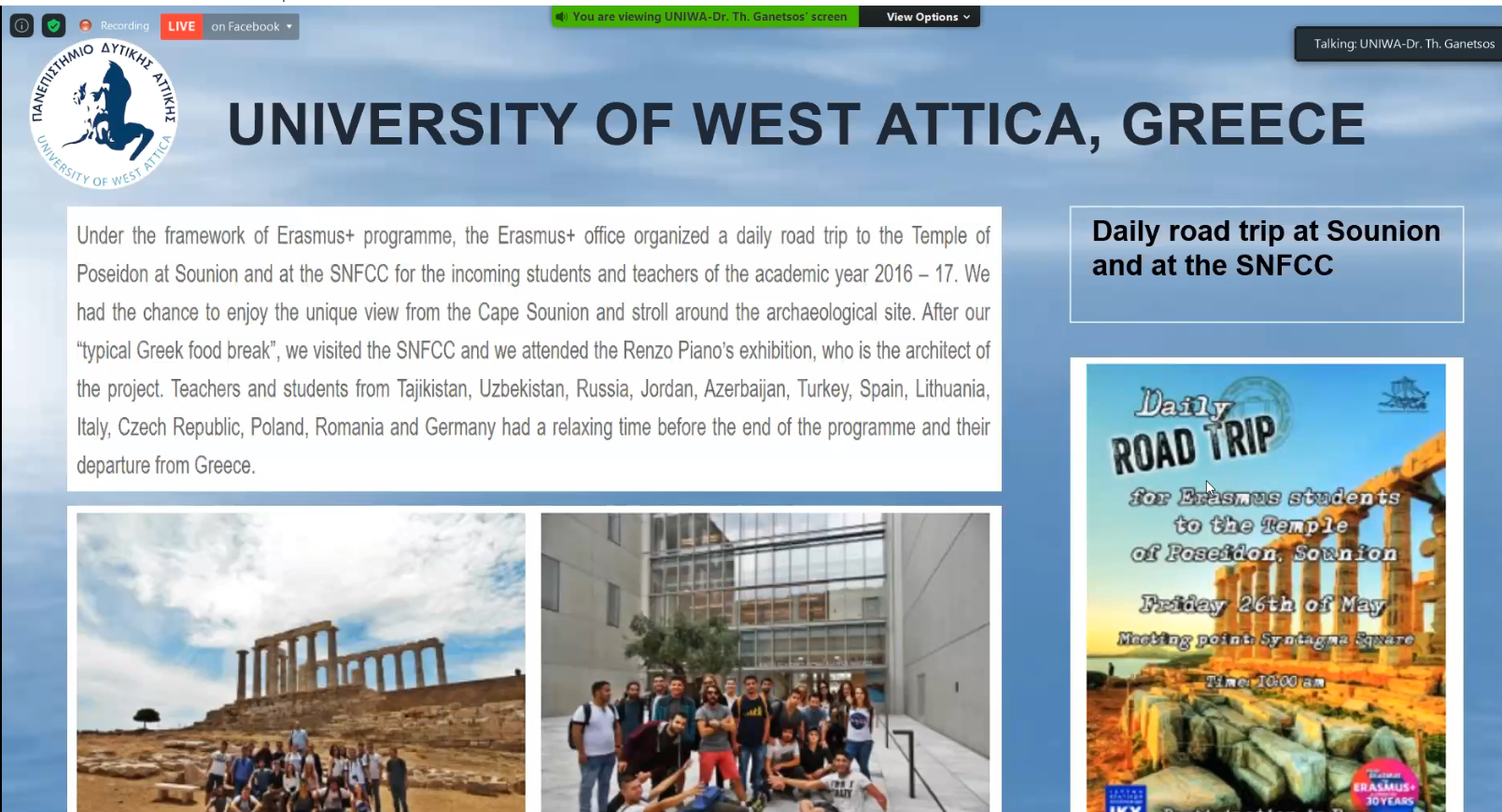

Road trips and farewell dinners
for Eramus+ students
Prof Theodore then
moved on to explain the culture—Celebration of Greece by sharing a video
presentation on the history of the Greek and Greek Revolution.
He also presented videos featuring two beautiful islands, namely
Crete and Santorini.
Before ending his
talk, Prof Theodore shared about the Erasmus Student Network (ESN network)
to the participants. He said,
“Erasmus Student Network (ESN) is a non-profit international student
organisation. Their mission is to represent international students, thus
providing opportunities for cultural understanding and self-development
under the principle of ‘students helping students’.”
Prof Theodore
concluded, “We are very excited to have this opportunity to participate in
the Magallanes World Study Tour with the Malaysian team. Athens is
beautiful. I hope all of you enjoyed our presentation today. Hope to see you
all one day at UniWA.”
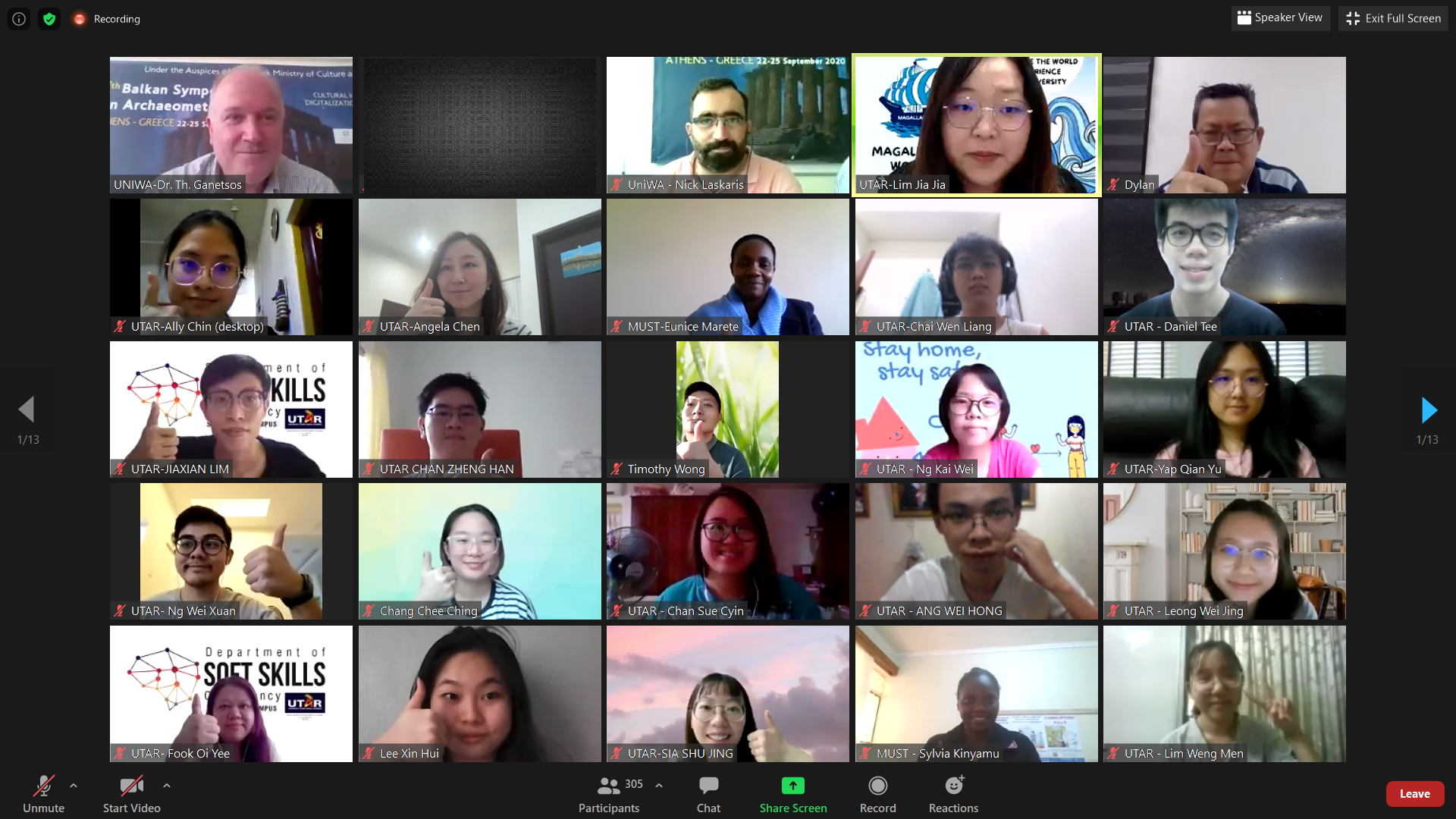
Group photo
Station 7: Hungkuang University
The next focus of the virtual “Magallanes World Study Tour” was
Hungkuang University, Taiwan. Titled “Travel to Taiwan from Home”, the
virtual tour was conducted on 10 August 2021 via Zoom. The event saw the
attendance of 490 students and staff from Hungkuang University, UTAR, and
partner universities.
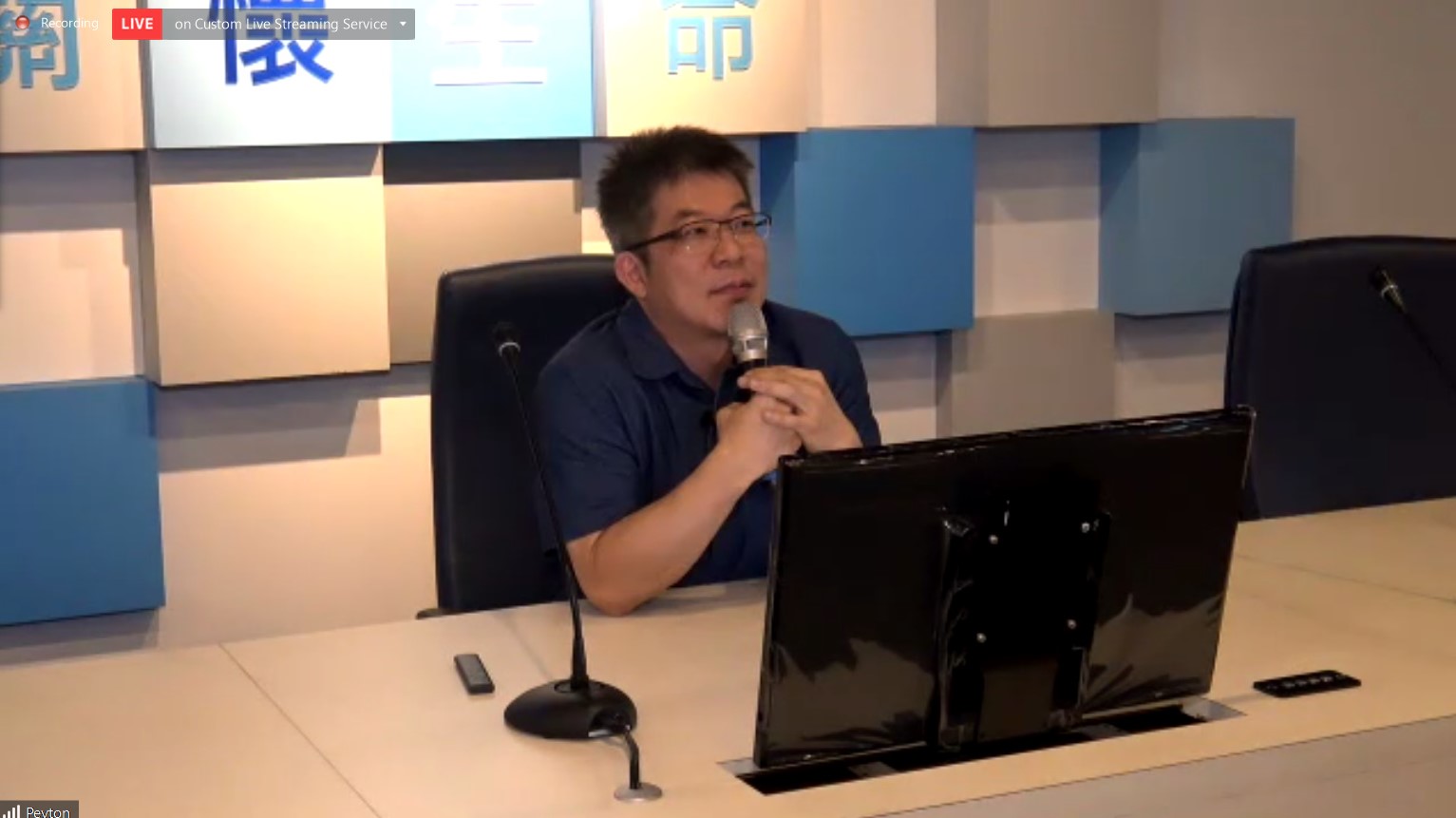
Tiger Tien welcoming UTAR students to
visit Hungkuang University in the future
Giving an opening remark at the event was Hungkuang University Office of International and Cross-strait Affairs Dean Tiger Tien. “This is a very good programme for all of our students. We can learn about different cultures, opinions and people from this event. So I also encourage our students to join this incredible event. I welcome all of you to visit Taiwan in the future,” he said.
He then started by introducing Taiwan, a beautiful island graced
with stunning natural scenery, rich traditional and modern culture, and
delicious food. He shared some history and facts about Taiwan, and mentioned
that Taiwan was ranked as one of the best in the world in terms of the
healthcare system, semiconductor factory, and the safest place to visit for
foreigners.
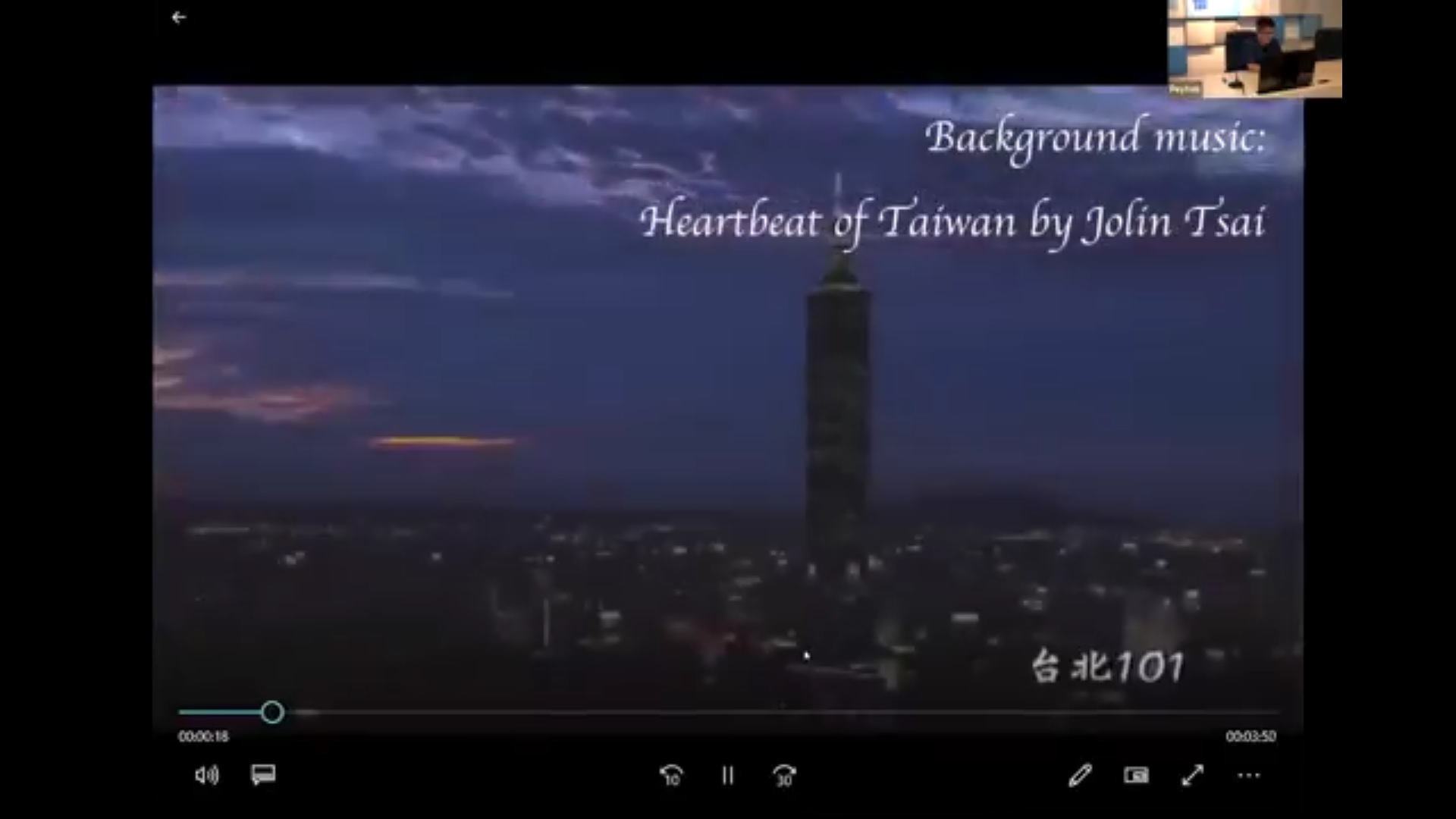

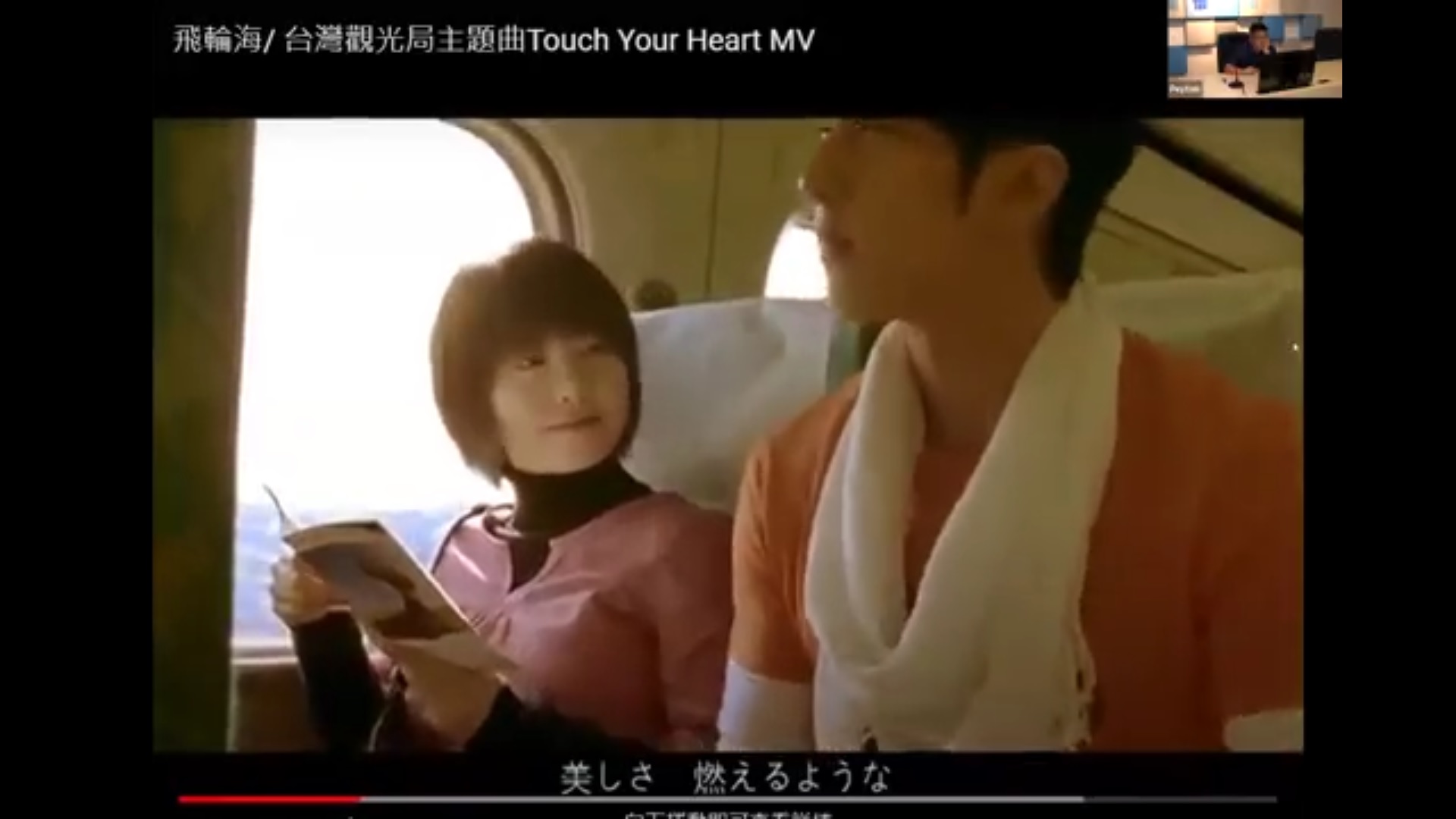
Clockwise, from top left: Music videos titled “Heartbeat of Taiwan”(台湾心跳声),
“Beyond Beauty: Taiwan from above”(看見台灣) and “Touch Your Heart” were played during the event to enhance the
audience’s understanding about this beautiful island
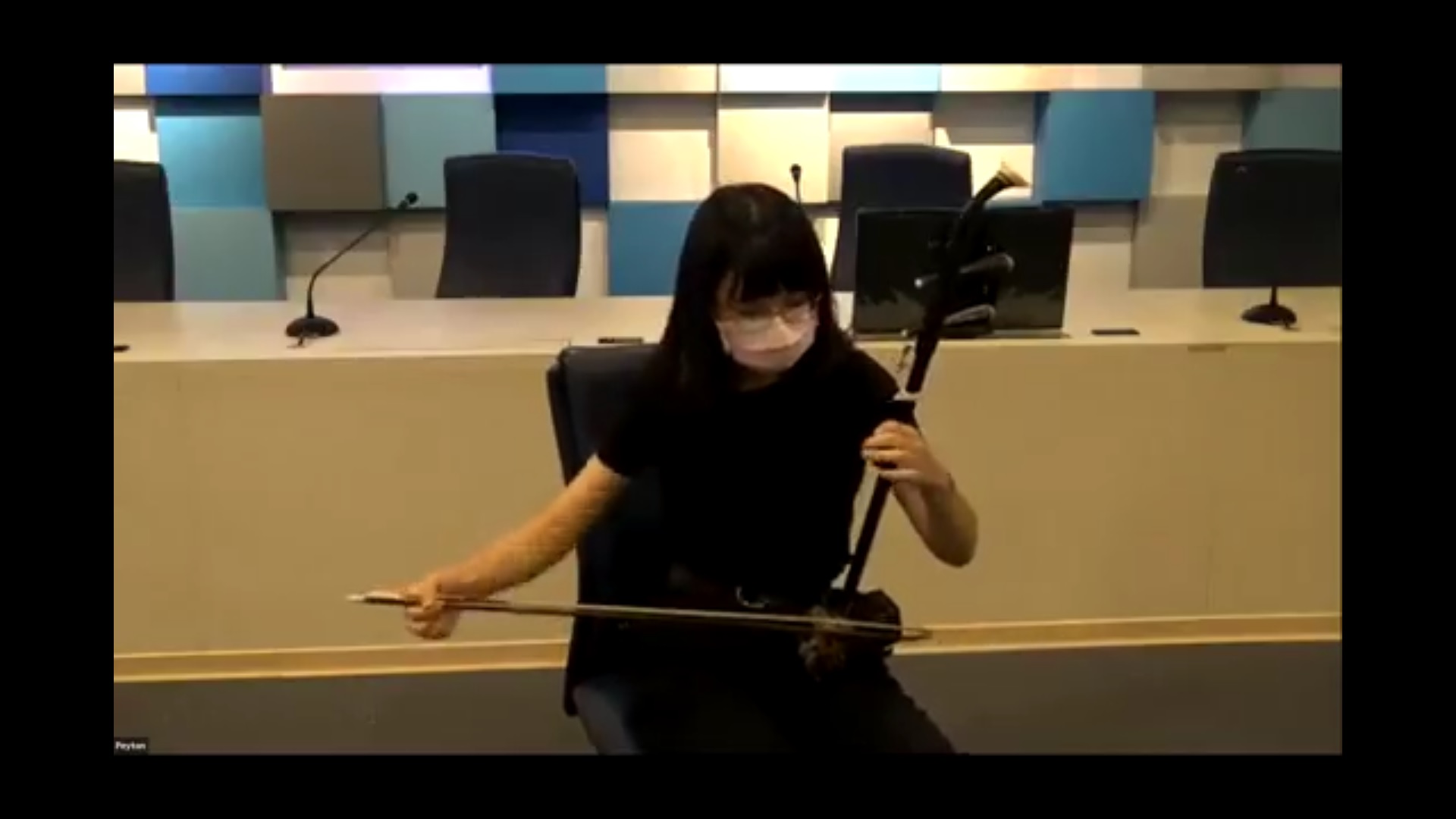
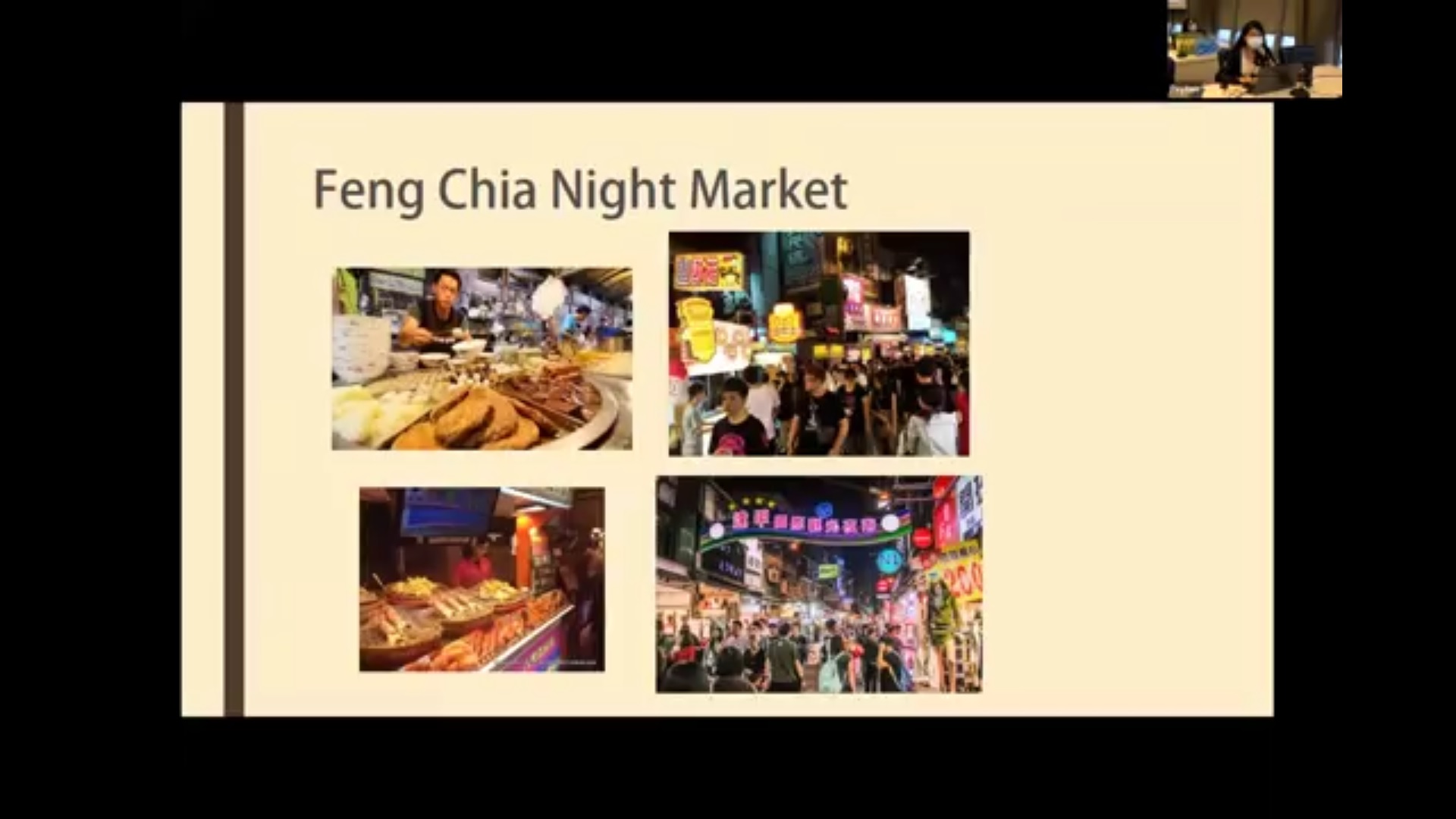
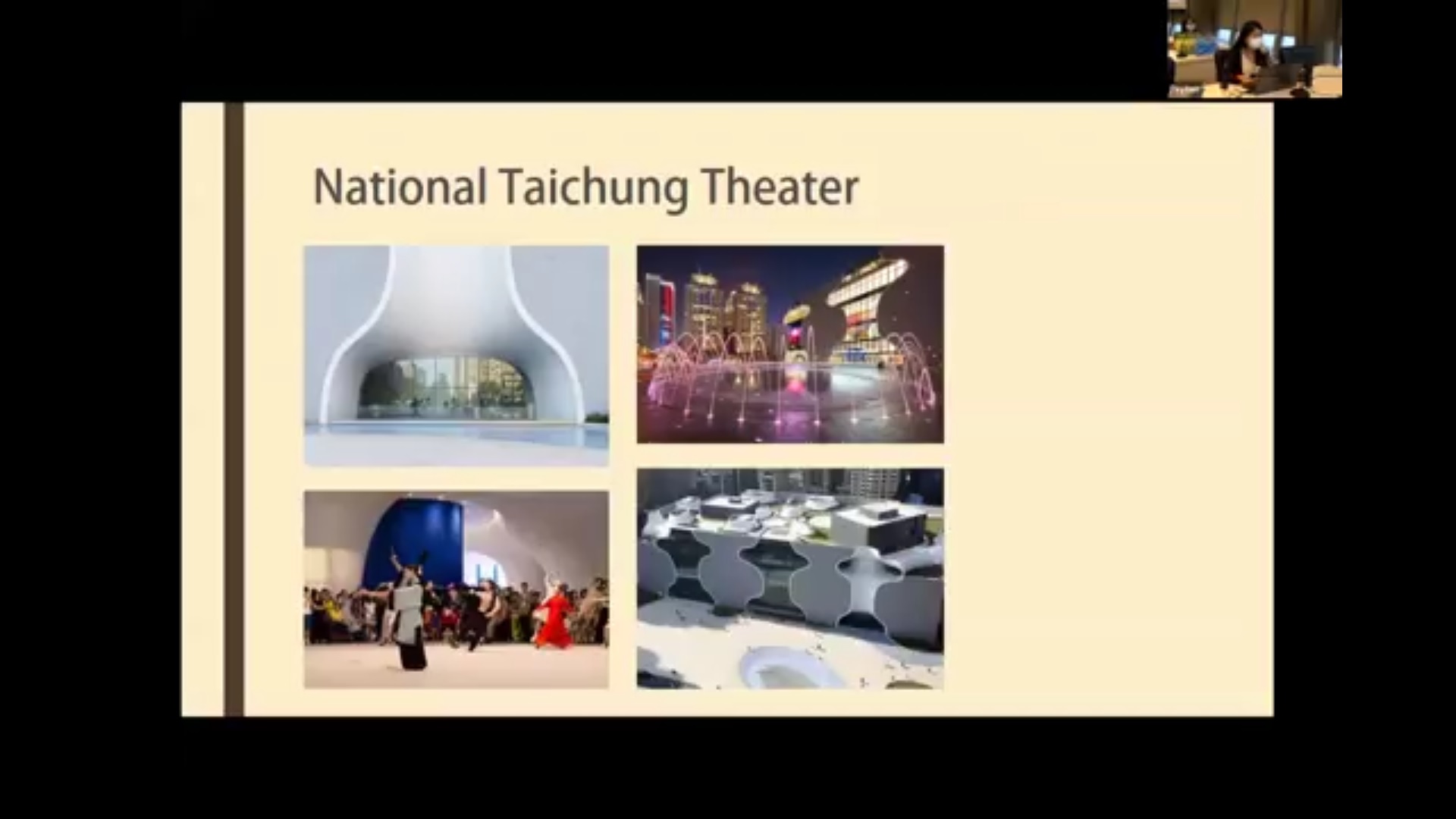
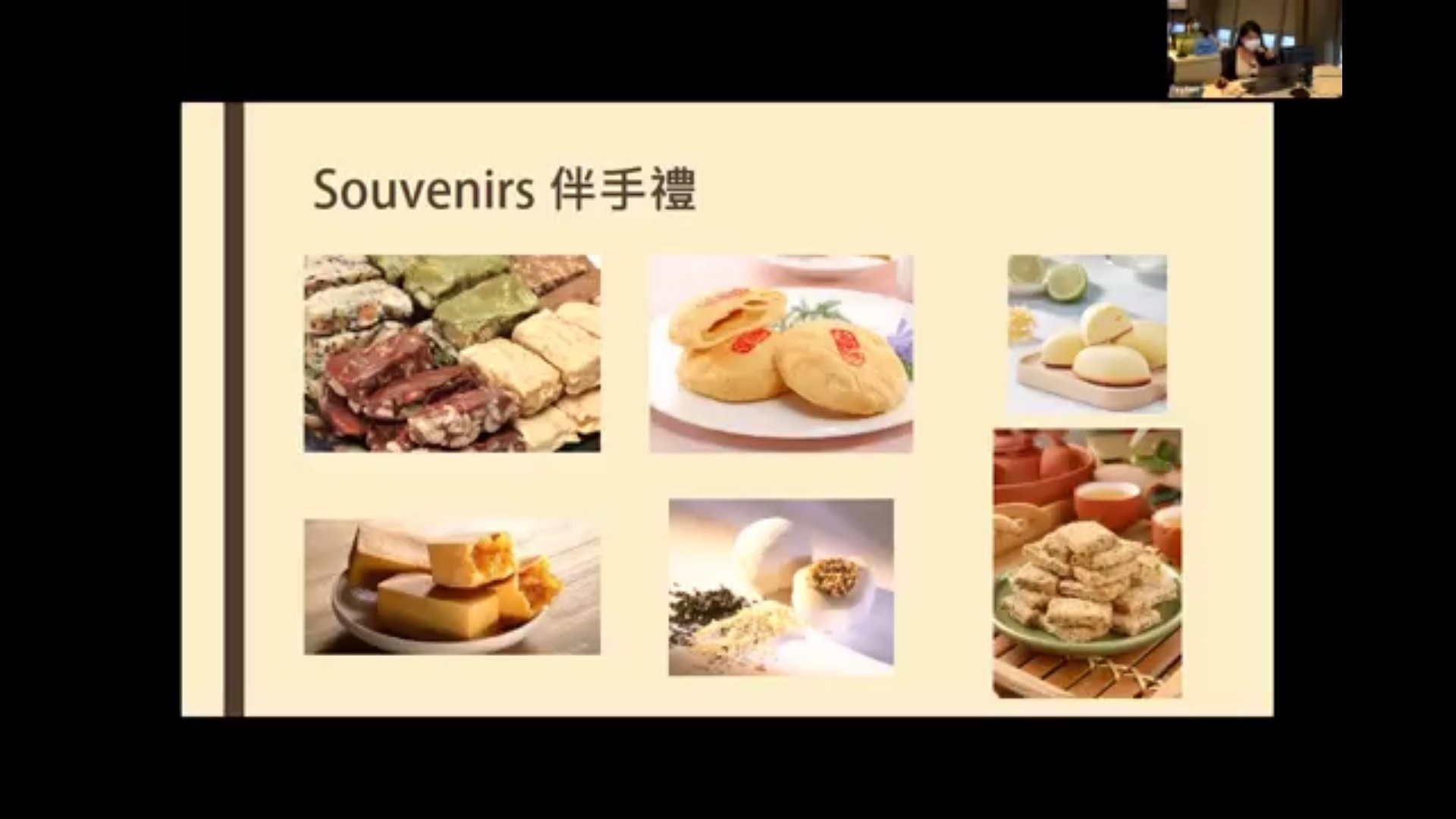
Taichung
offers plenty to satisfy one’s thirst for food and culture
The event also introduced Taichung, the second-largest city in
Taiwan. Taichung enjoys a mild-year round climate with an average
temperature of 22.4 degrees centigrade. The city has a highly developed
industrial and commercial base, thriving cultural scenes, friendly people,
and beautiful scenery, all of which contribute to its status as an
international-class city. Among the famous icons to catch on while visiting
Taichung are the fancy-looking architecture at the National Taichung
Theater, night market and bubble tea. The event continued with a
presentation on the background and the development of Hungkuang
University. After the presentation on Hungkuang University, a virtual tour
video, which was led by two Malaysian students studying at the university,
was played.
Founded in 1967, Hungkuang University was initially established as
Hungkuang Junior College of Nursing. In response to changes and needs of the
times, the school was then elevated to Hungkuang Institute of Technology in
1997 and Hungkuang University in 2003. Presently, it has four faculties with
approximately 12,700 local students and 620 international students.
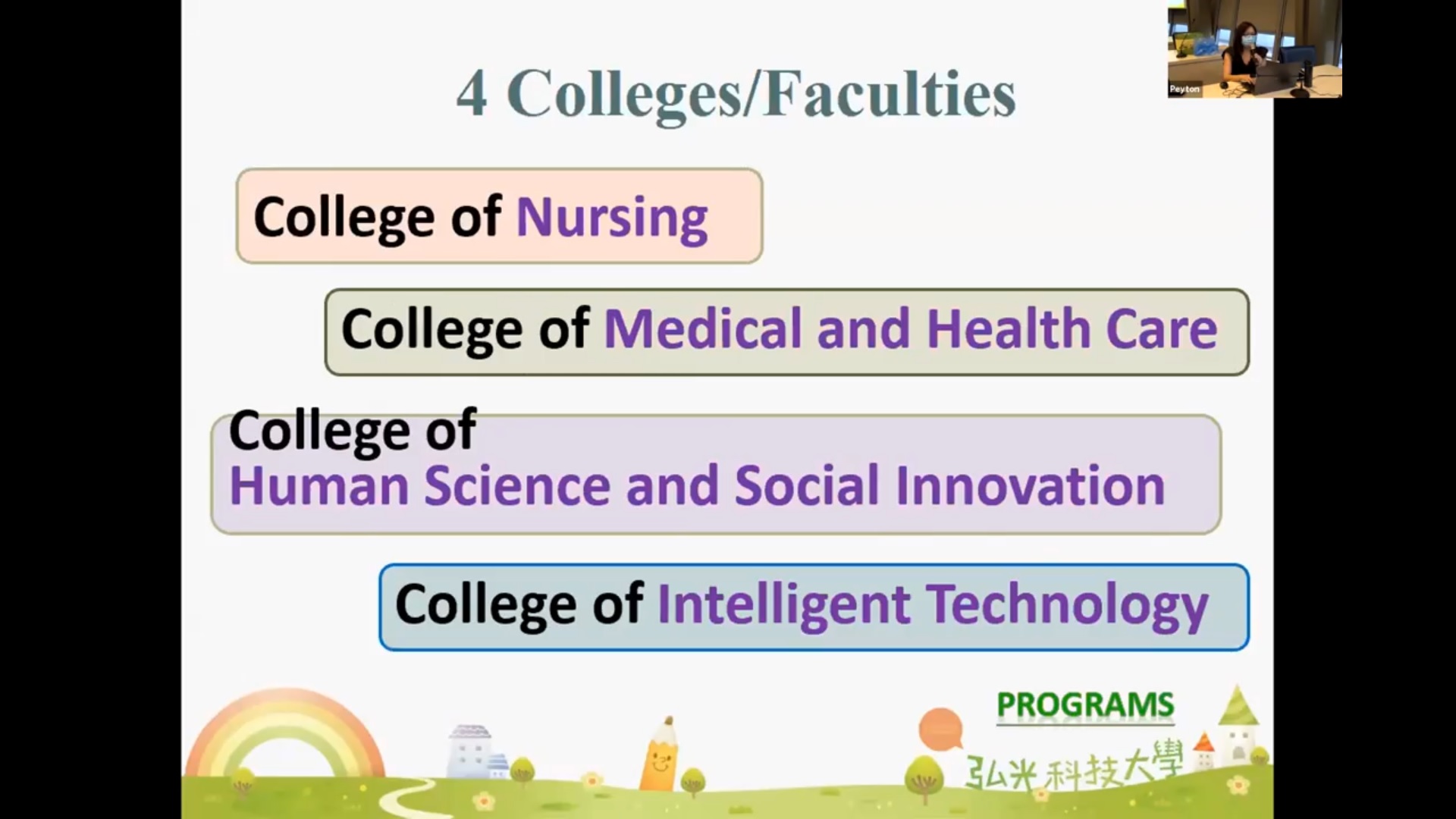
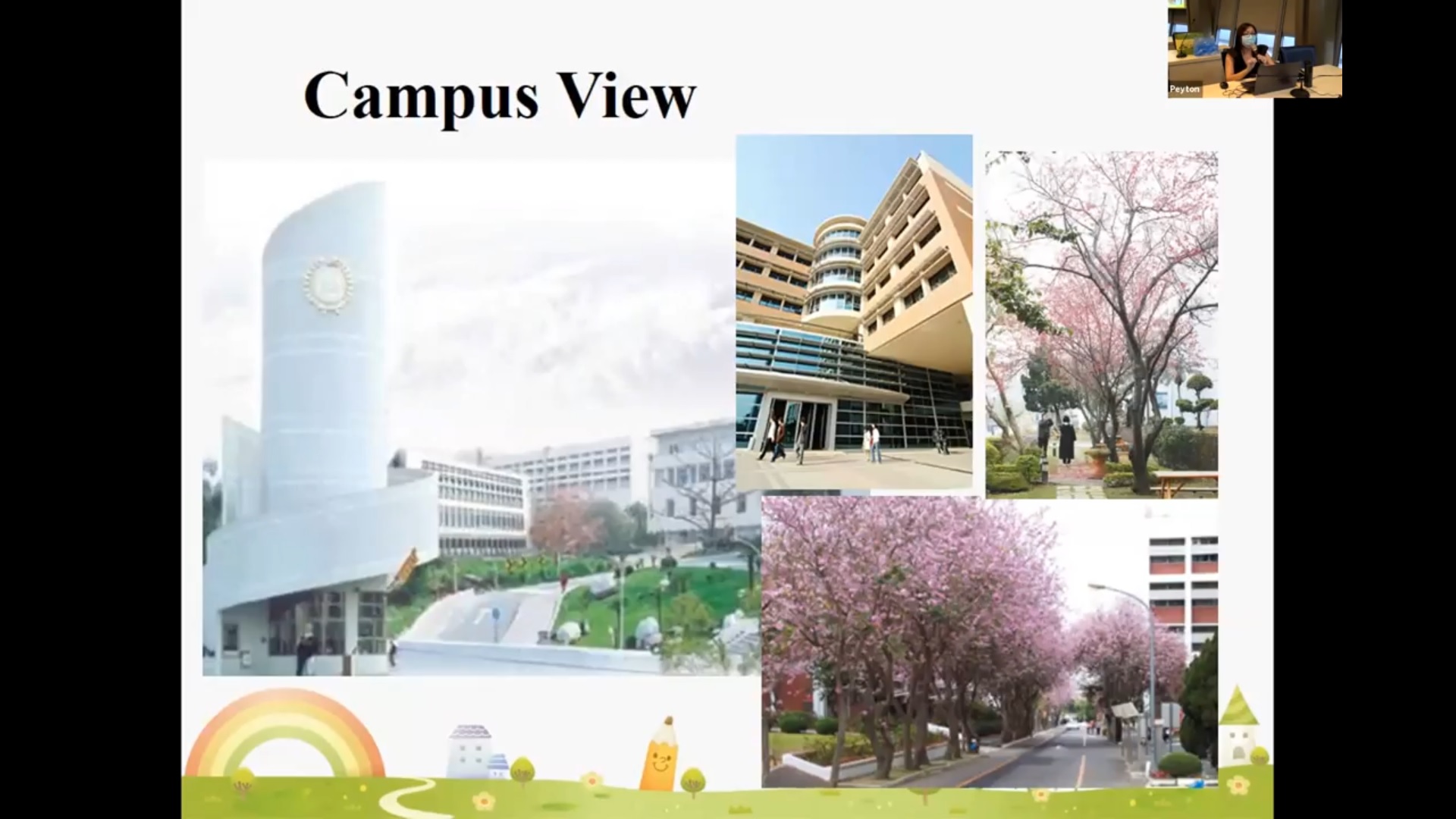
The participants were introduced to the background and the campus of Hungkuang University
© 2021 UNIVERSITI TUNKU ABDUL RAHMAN DU012(A).
Wholly owned by UTAR Education Foundation (200201010564(578227-M)) LEGAL STATEMENT TERM OF USAGE PRIVACY NOTICE